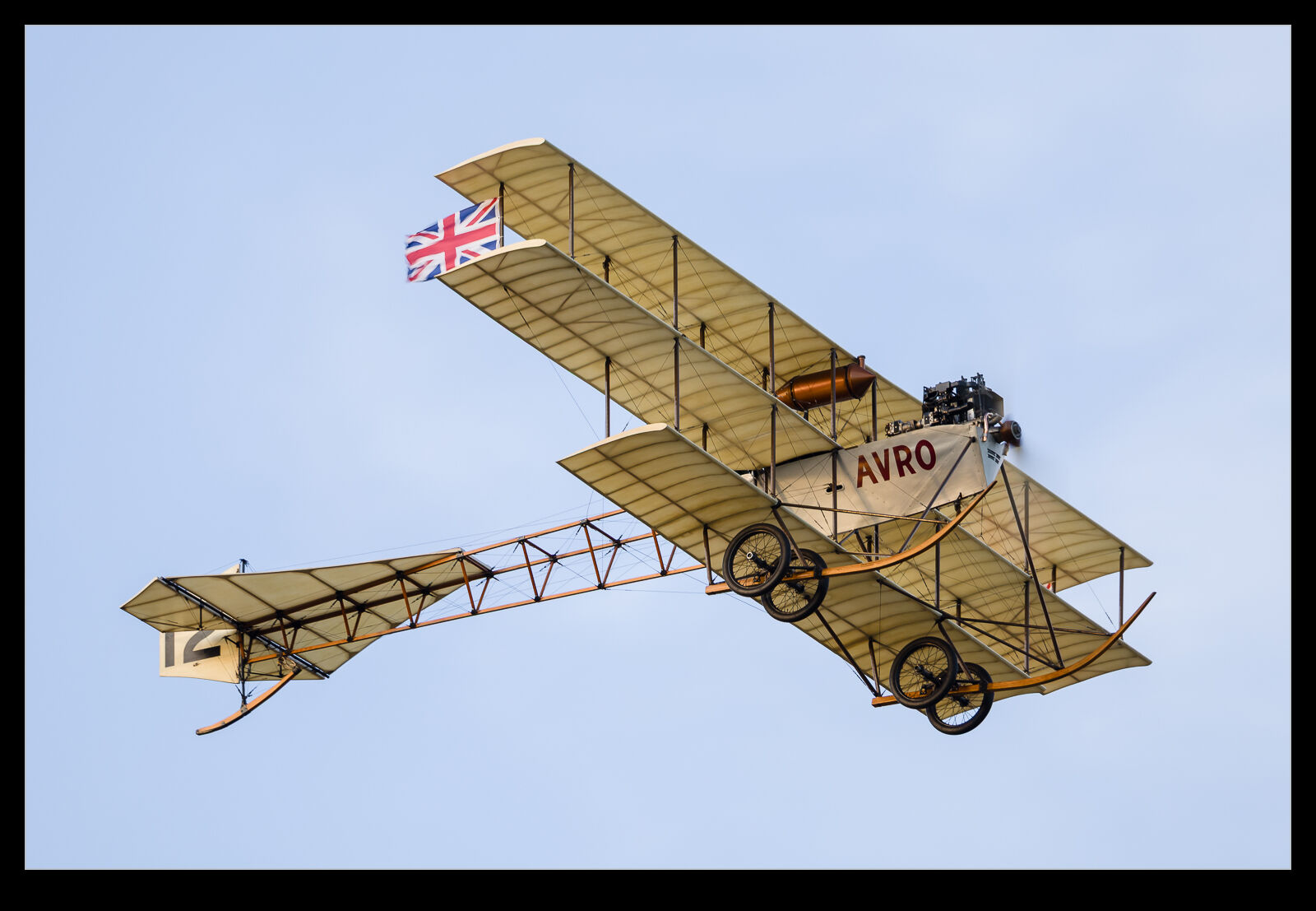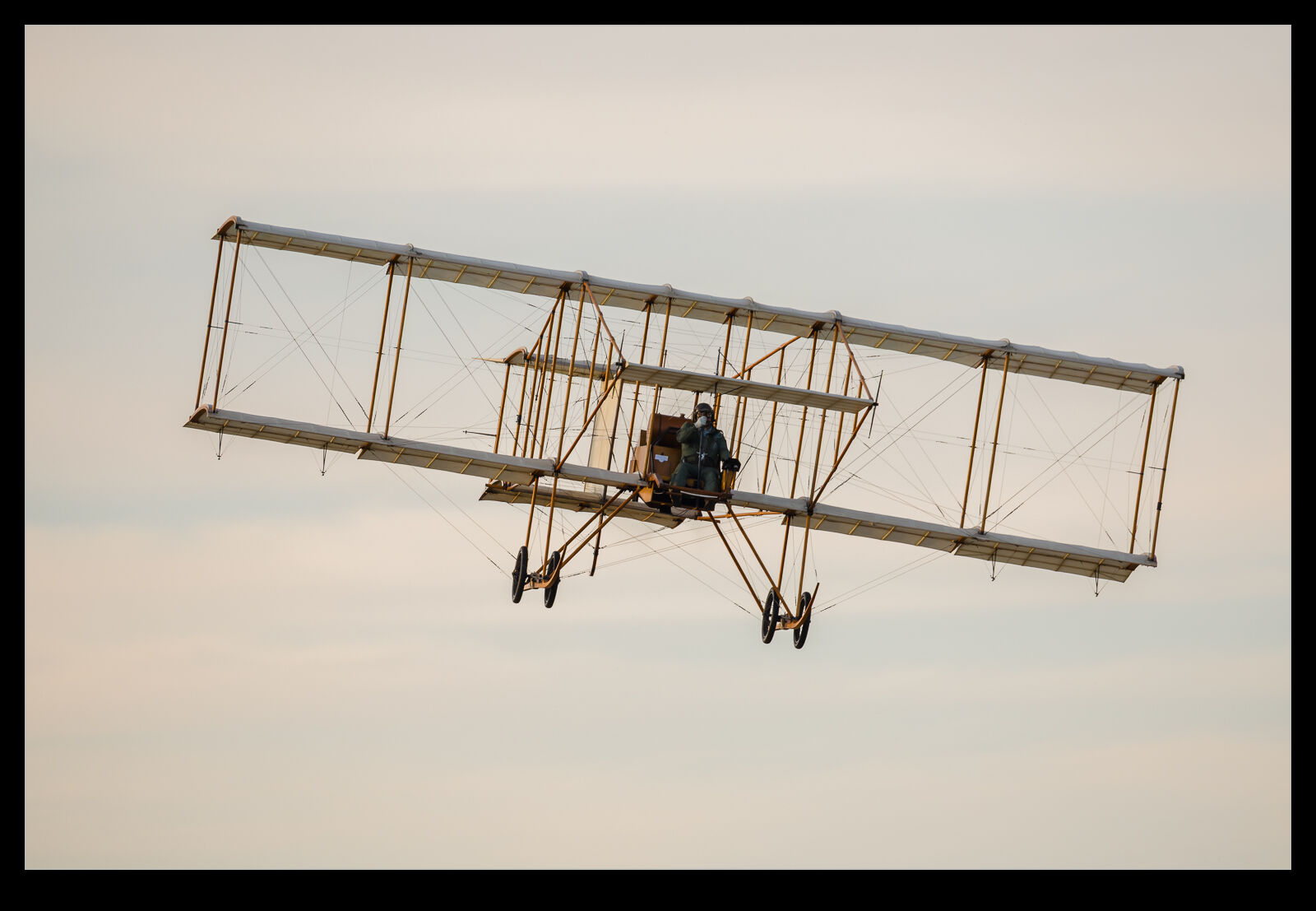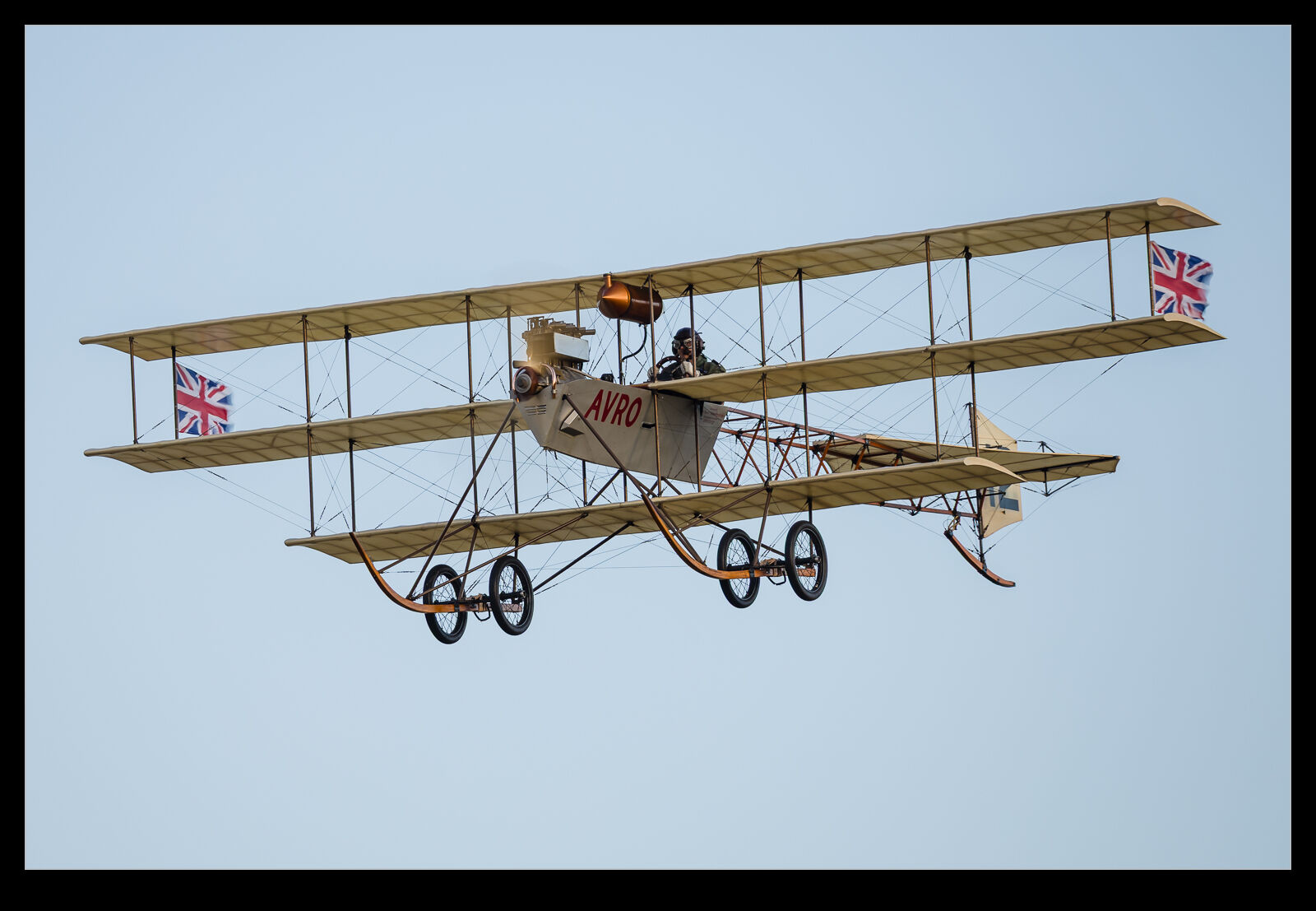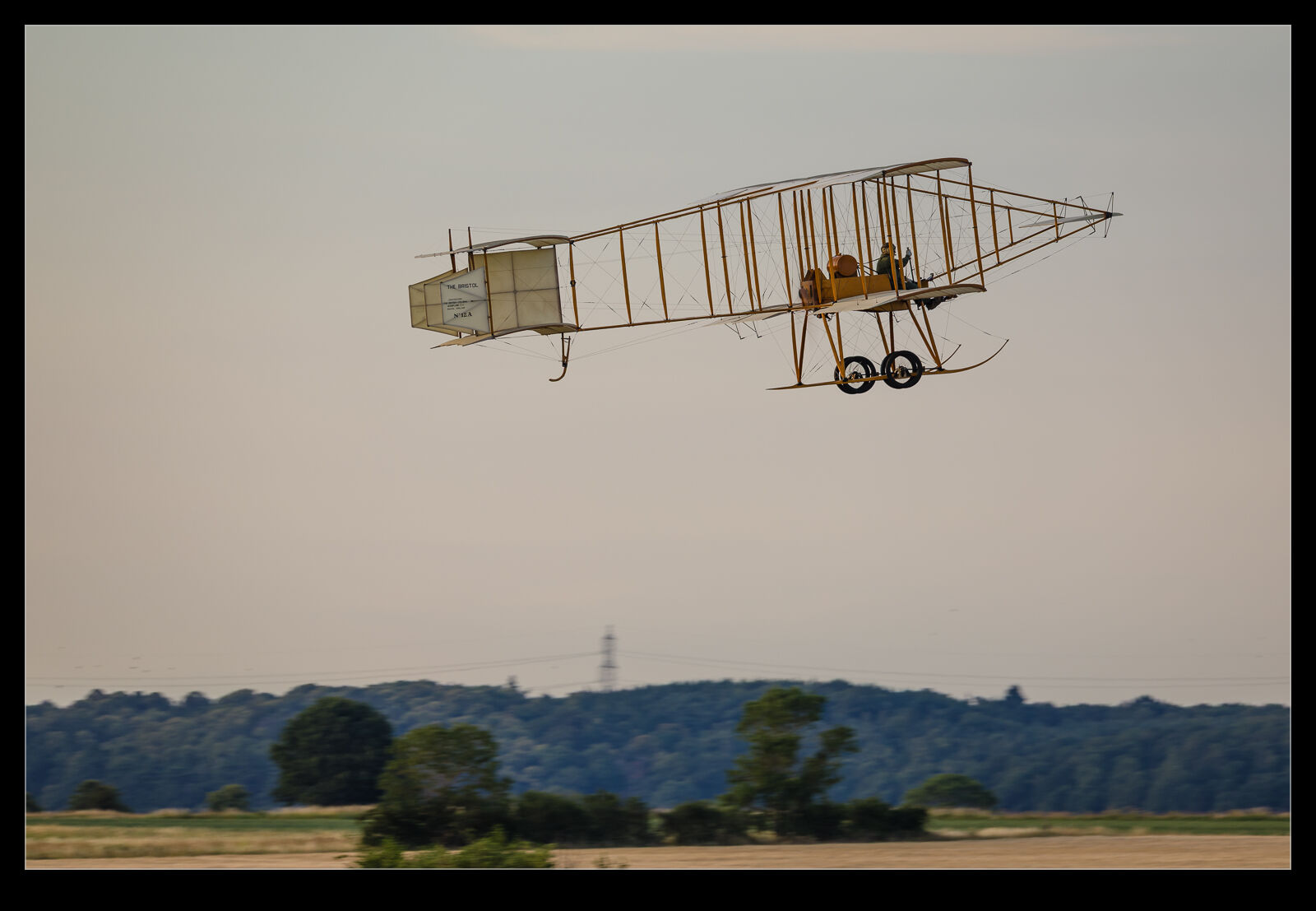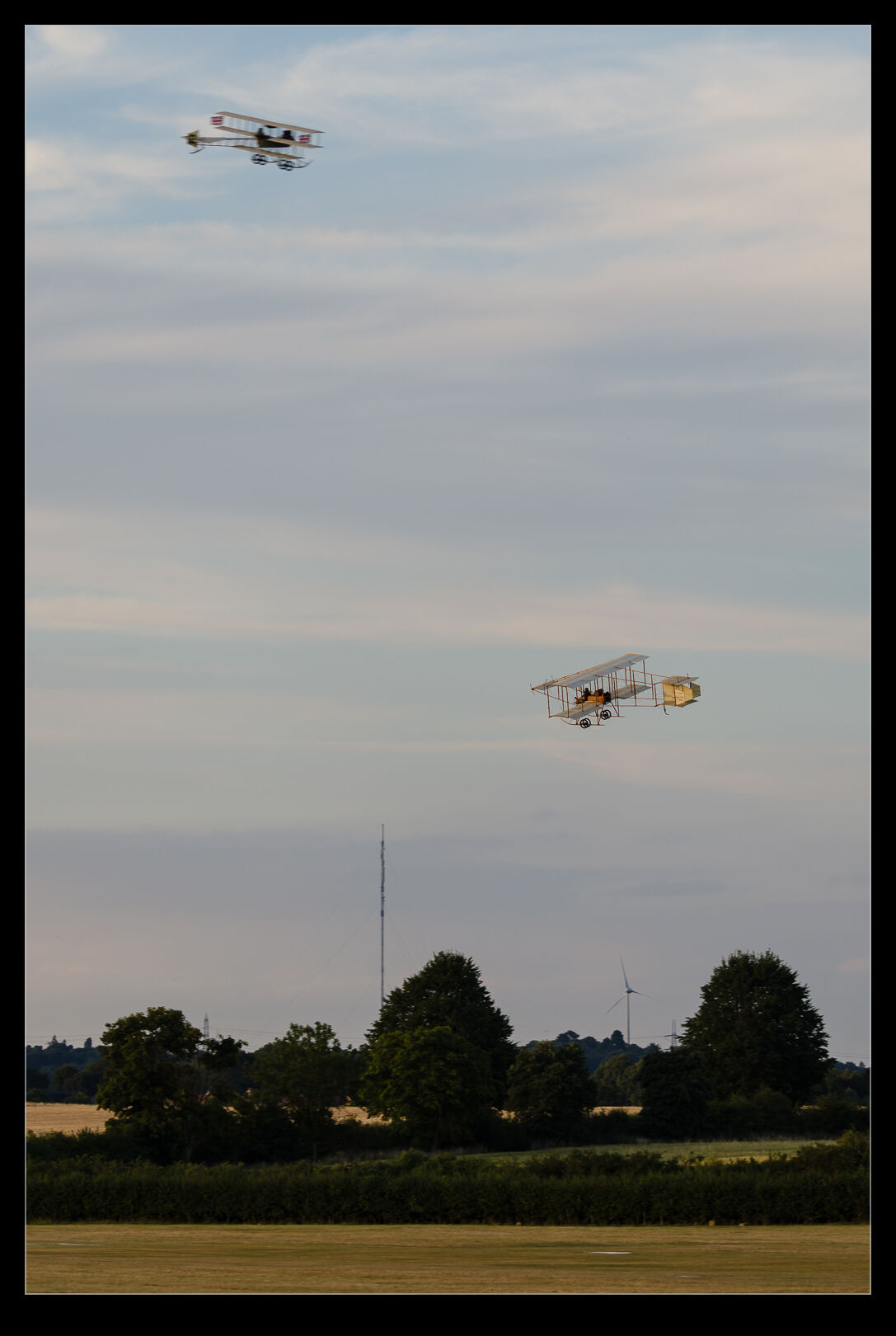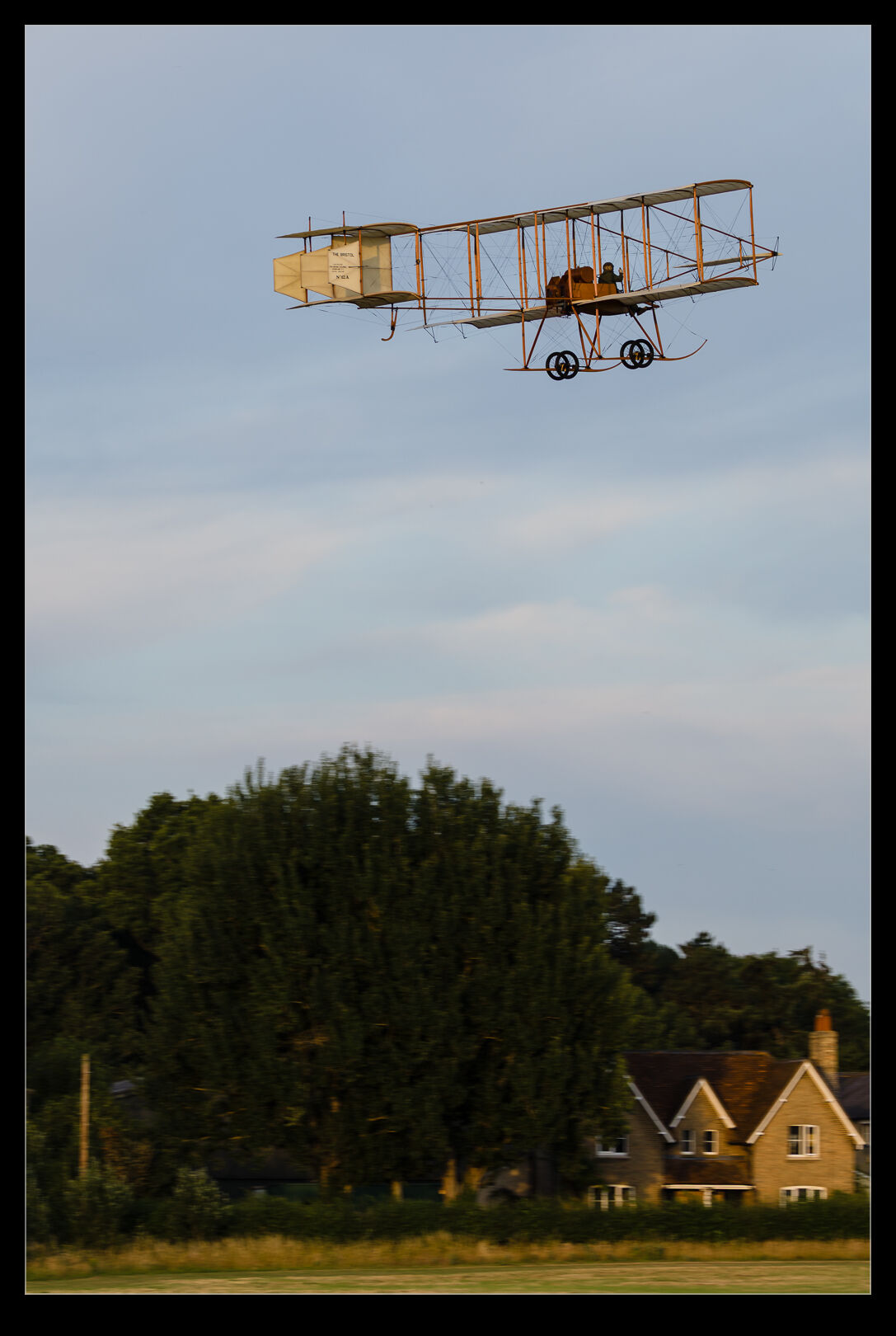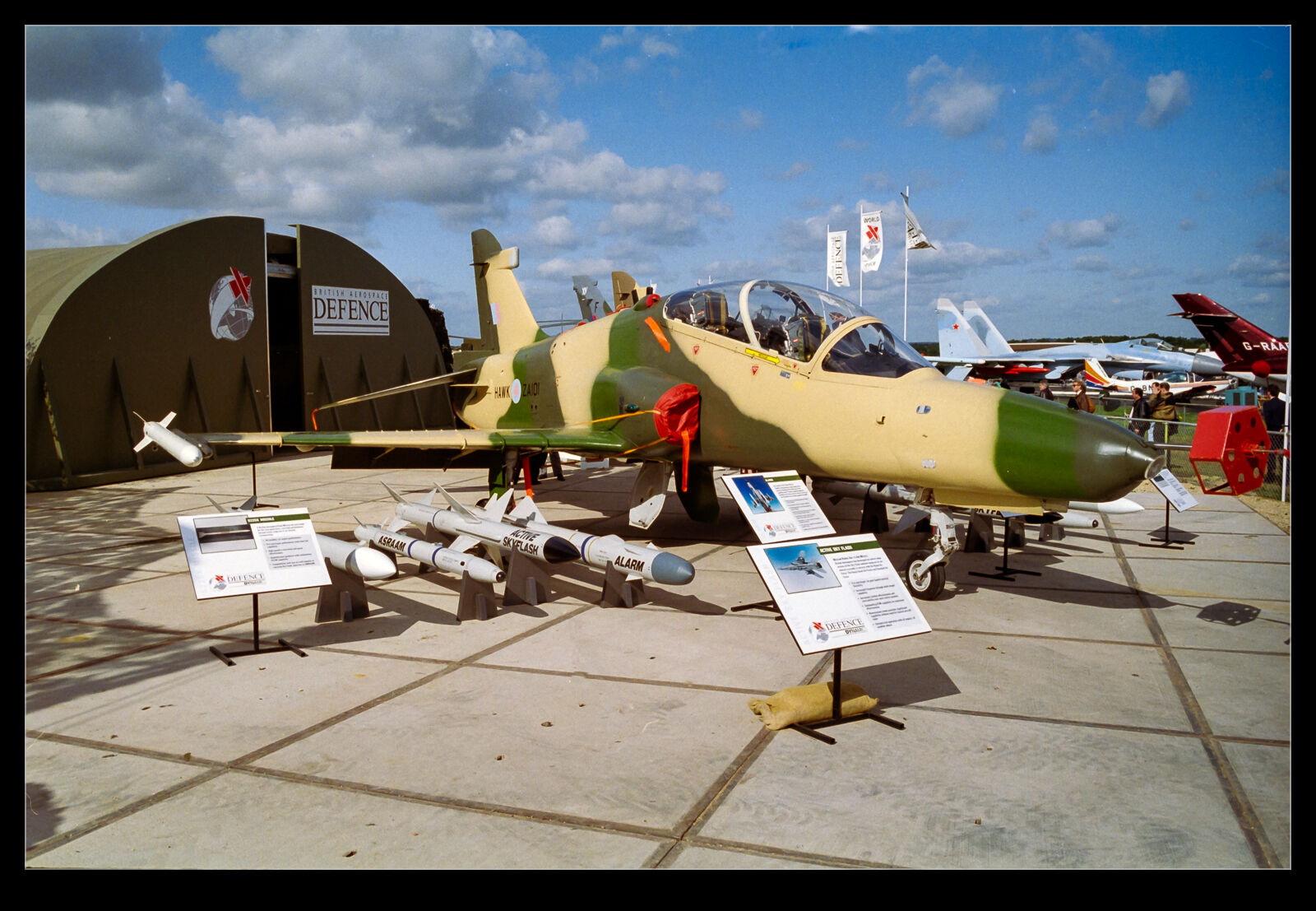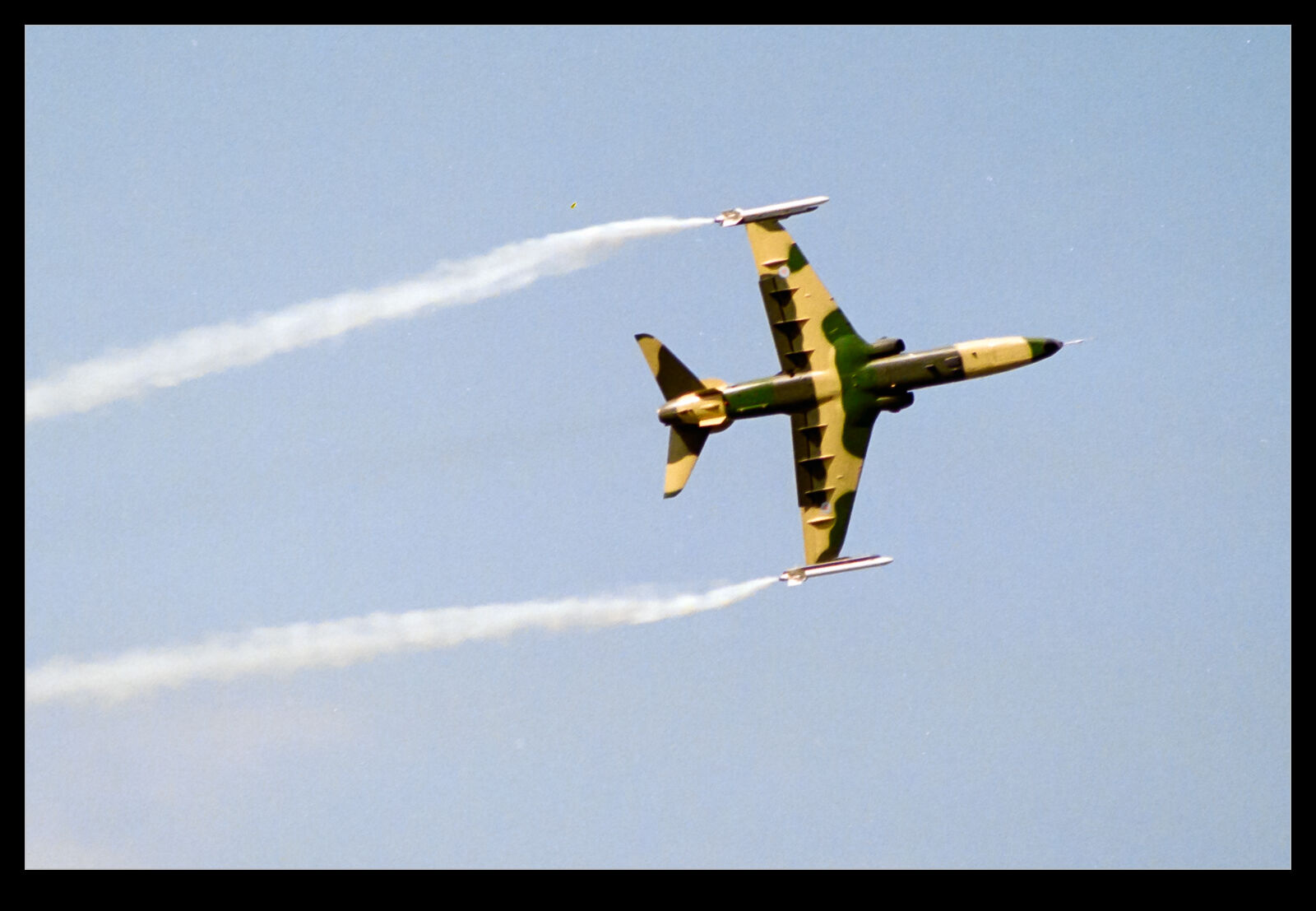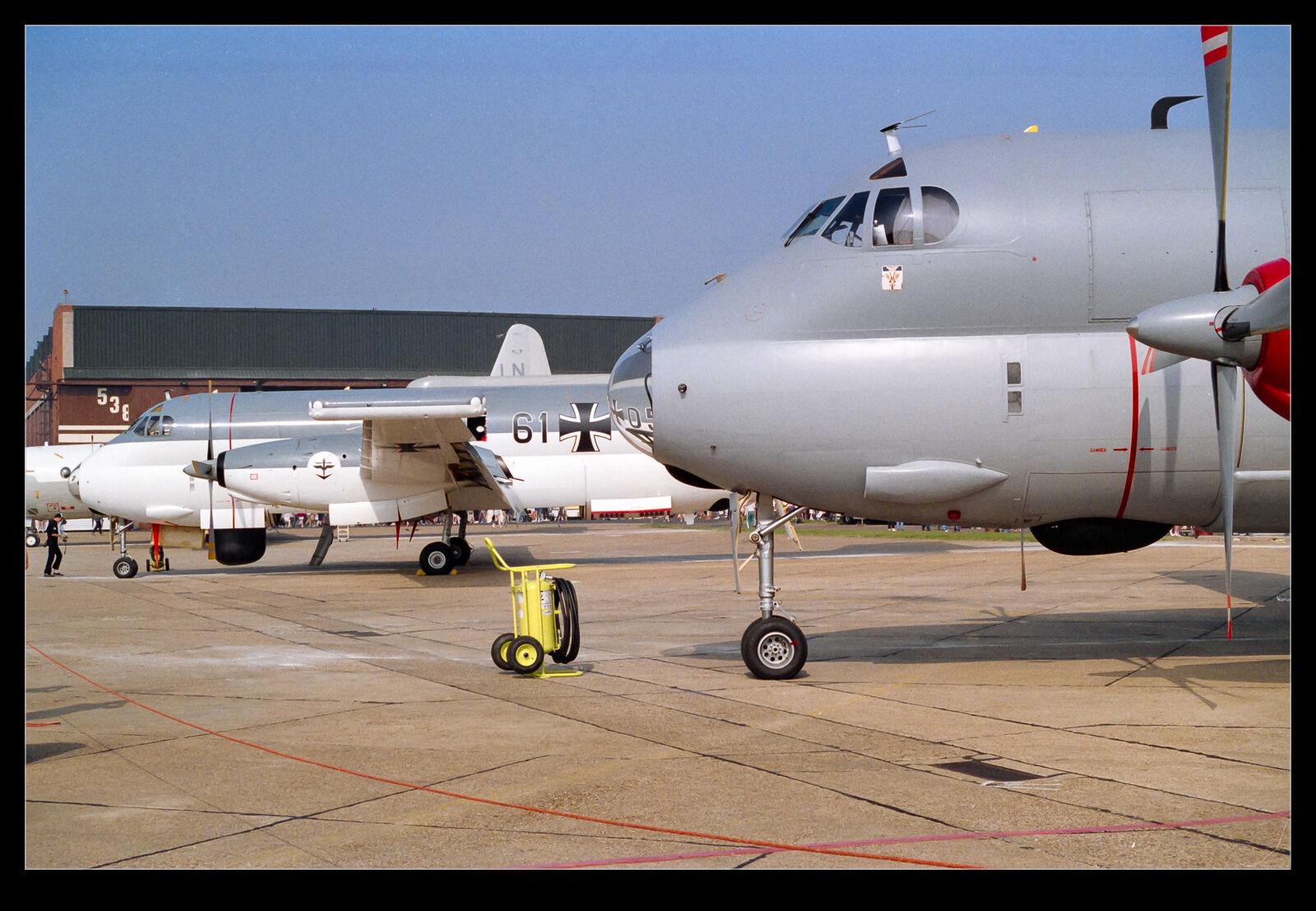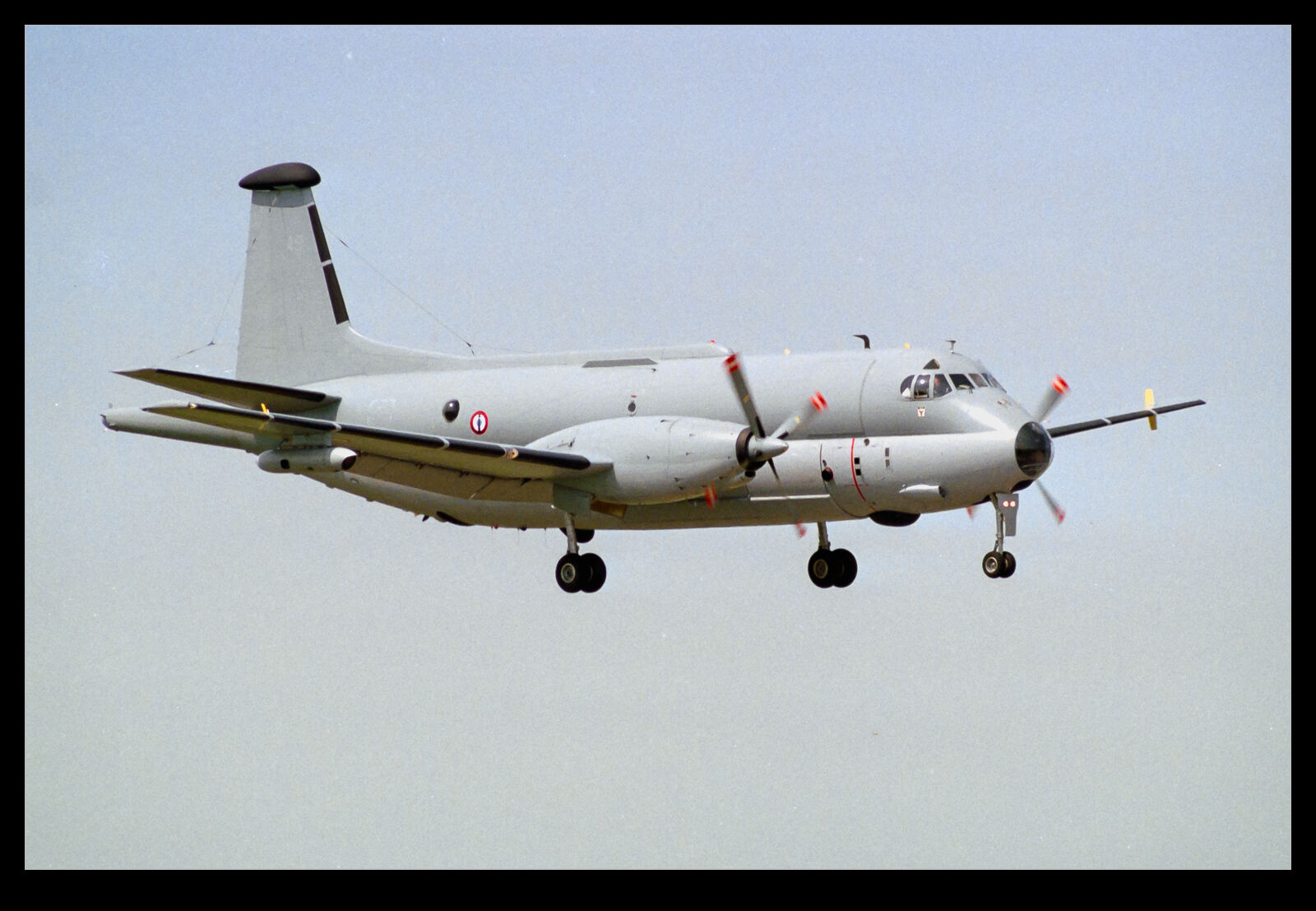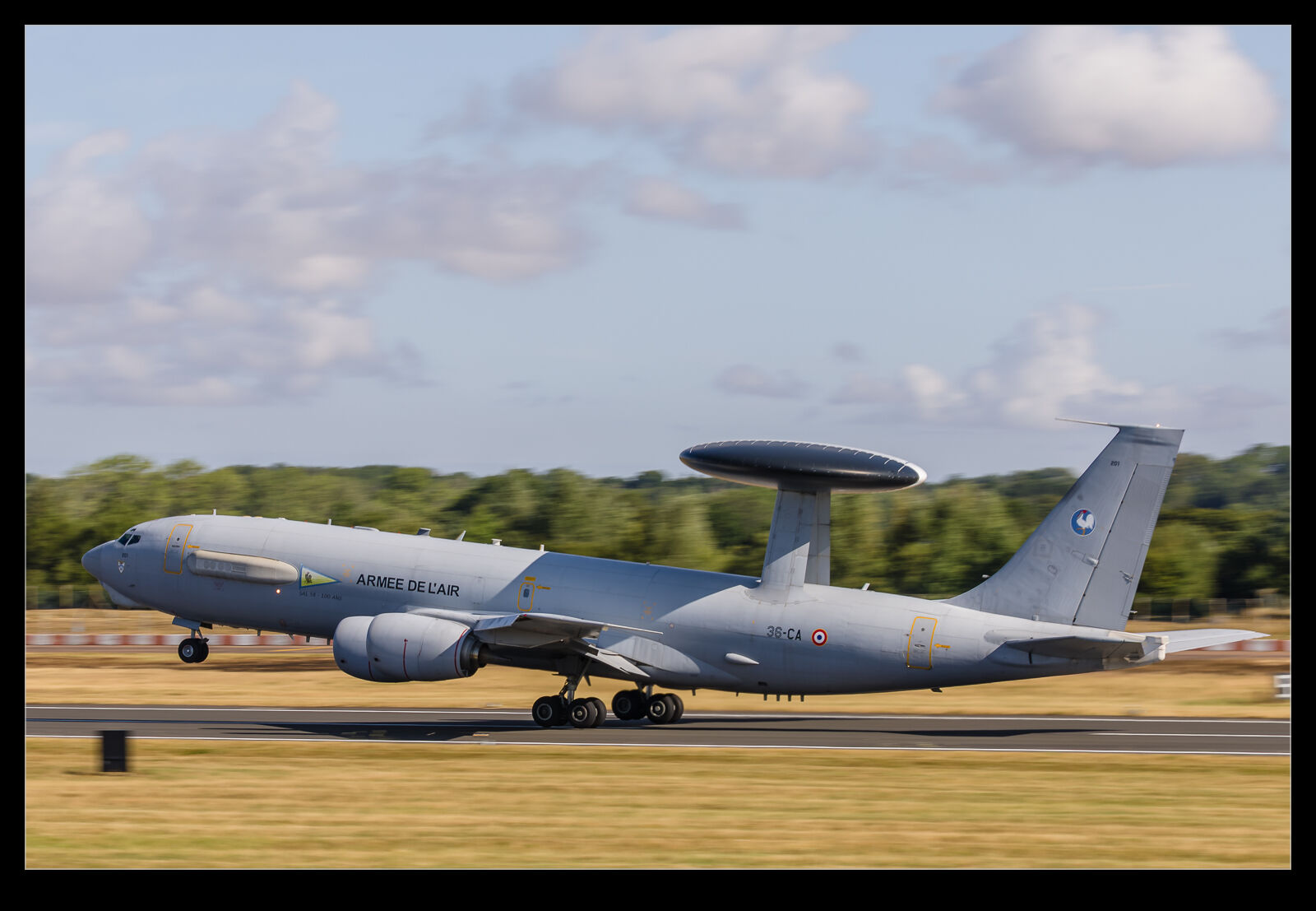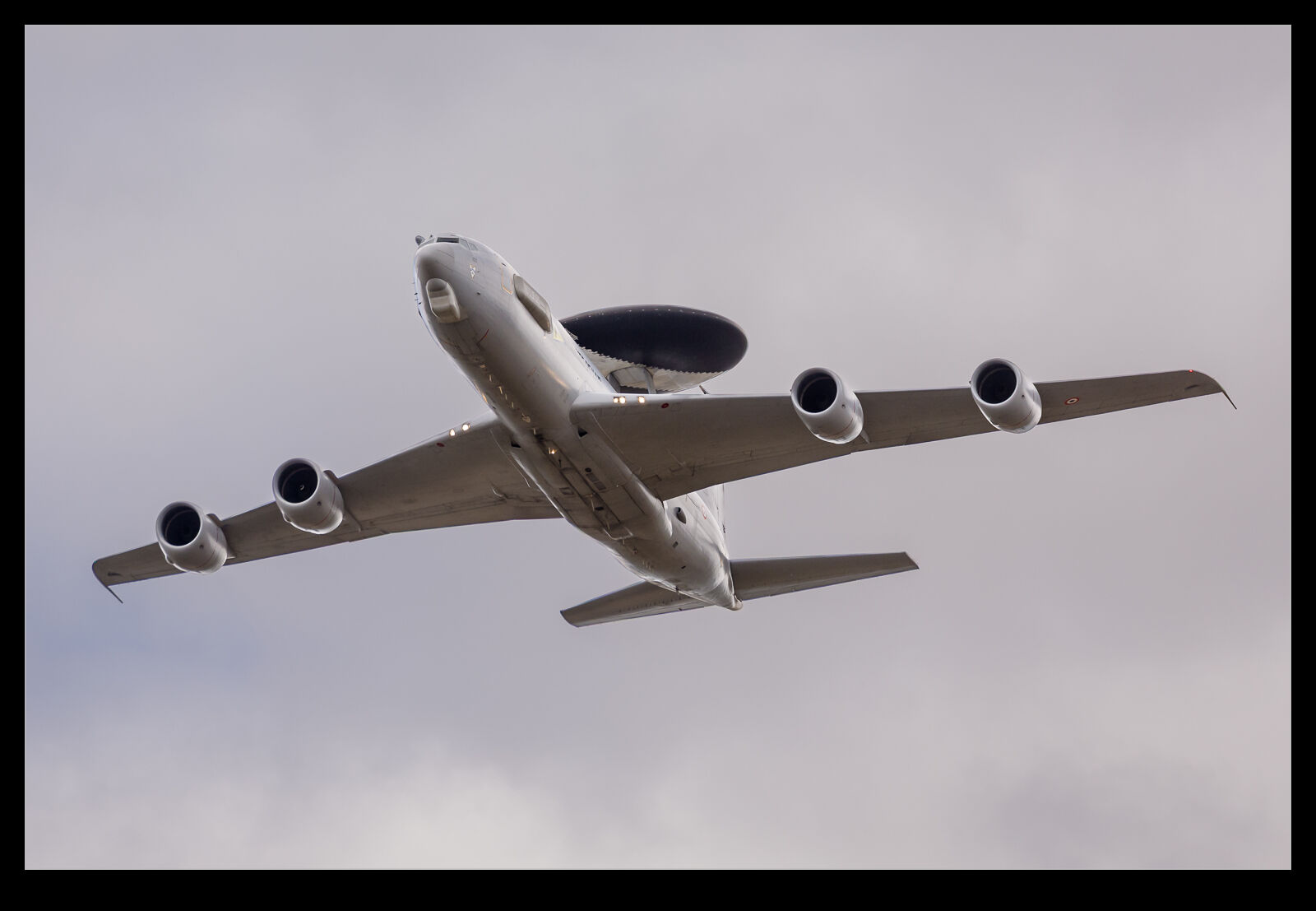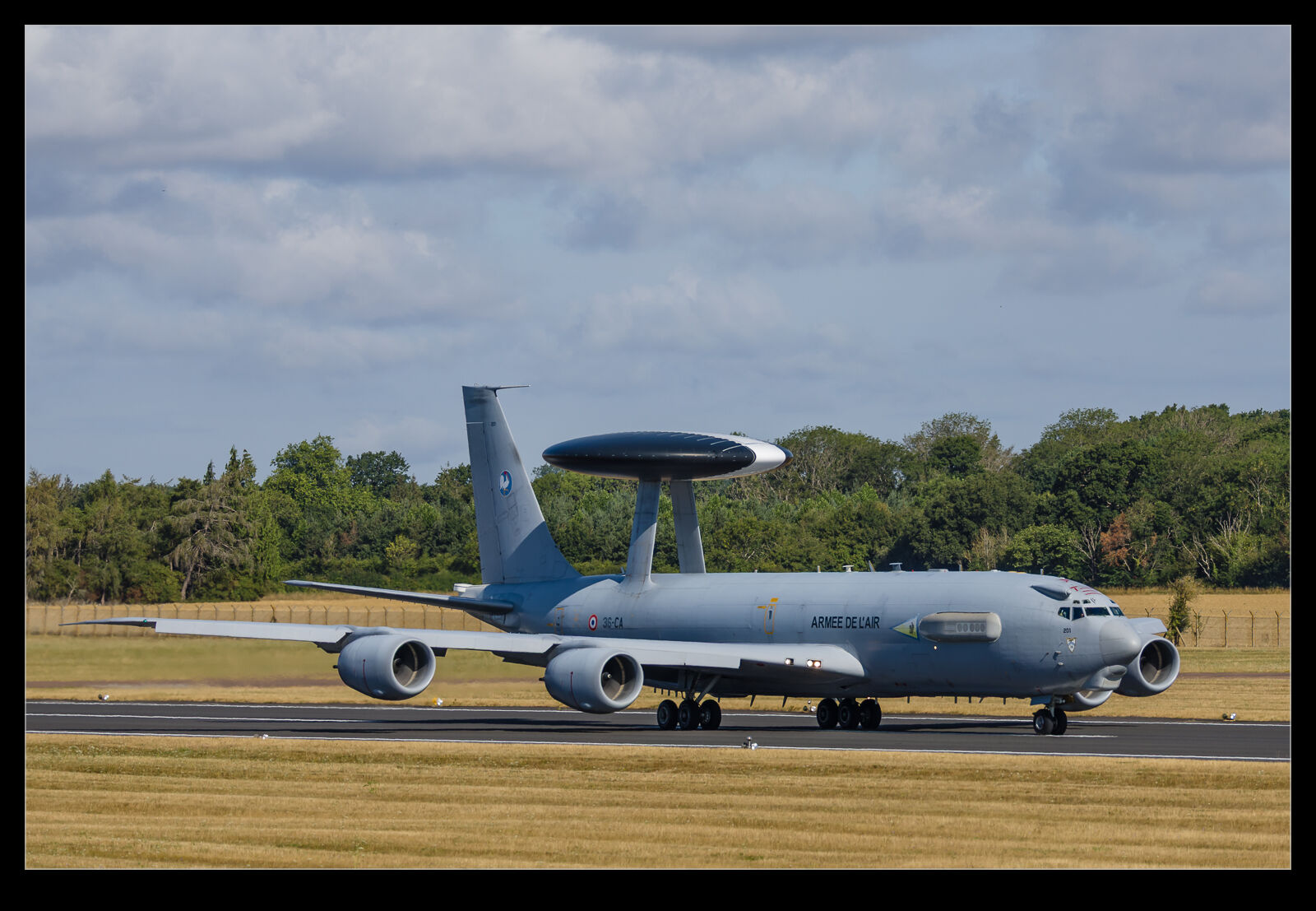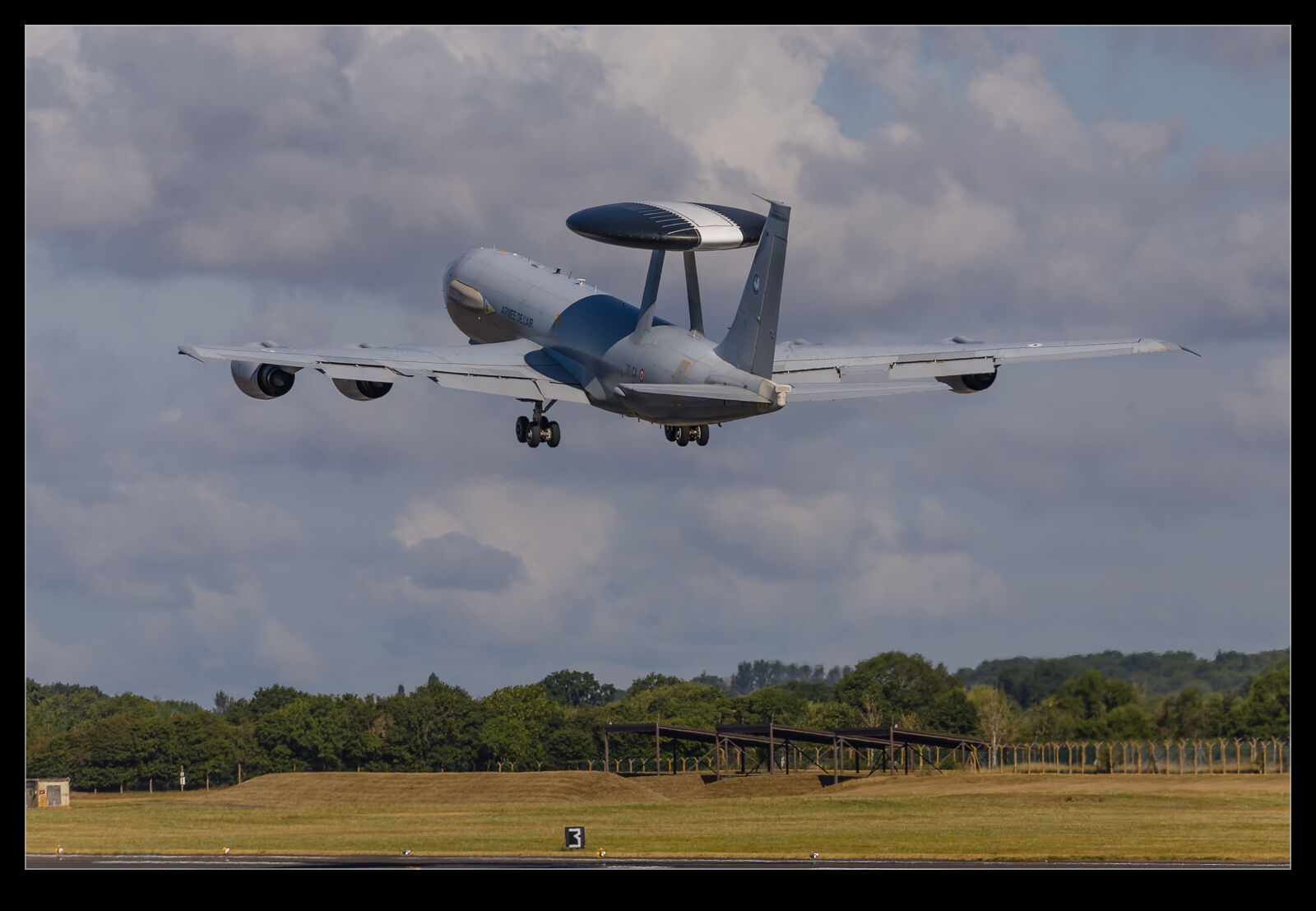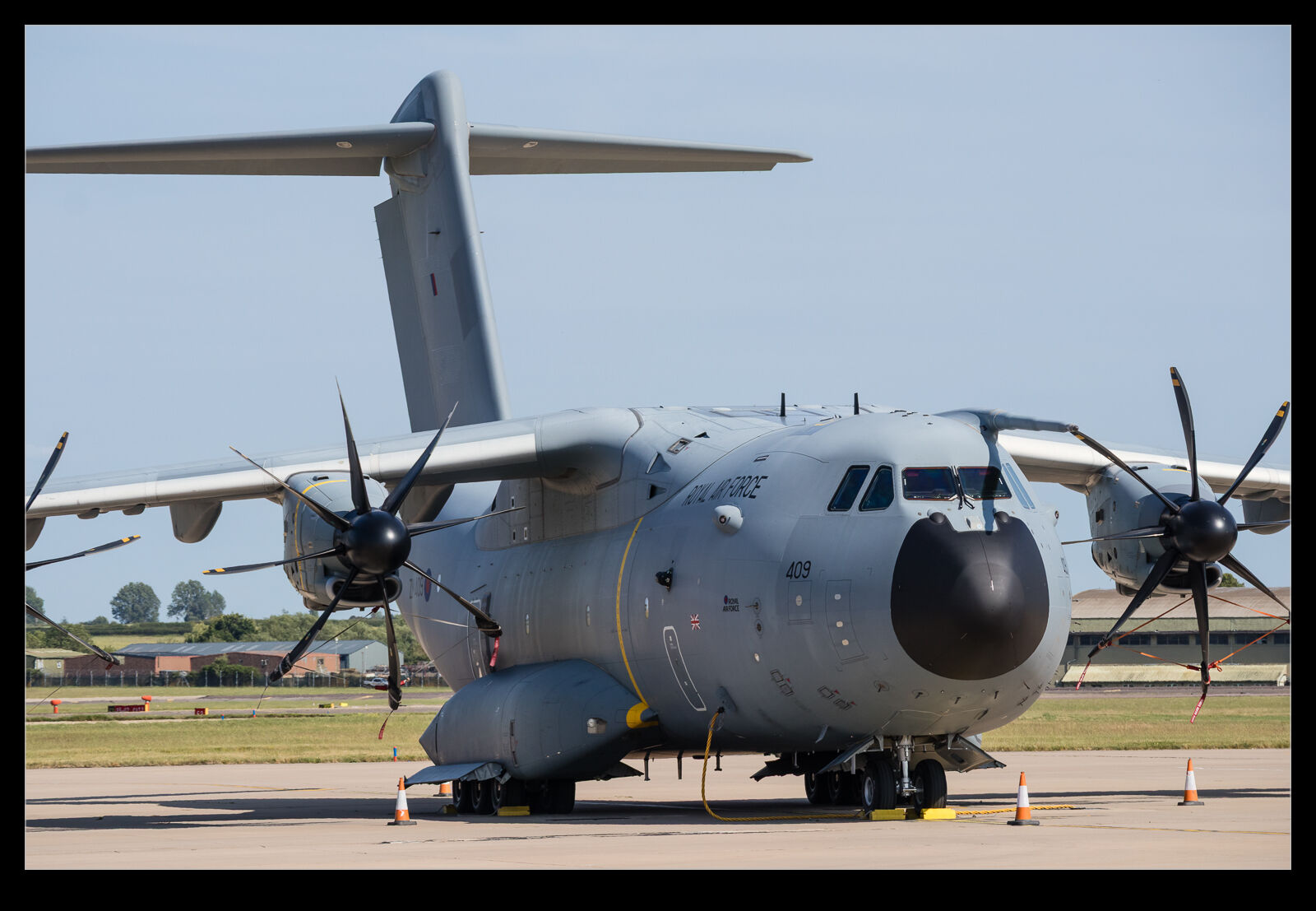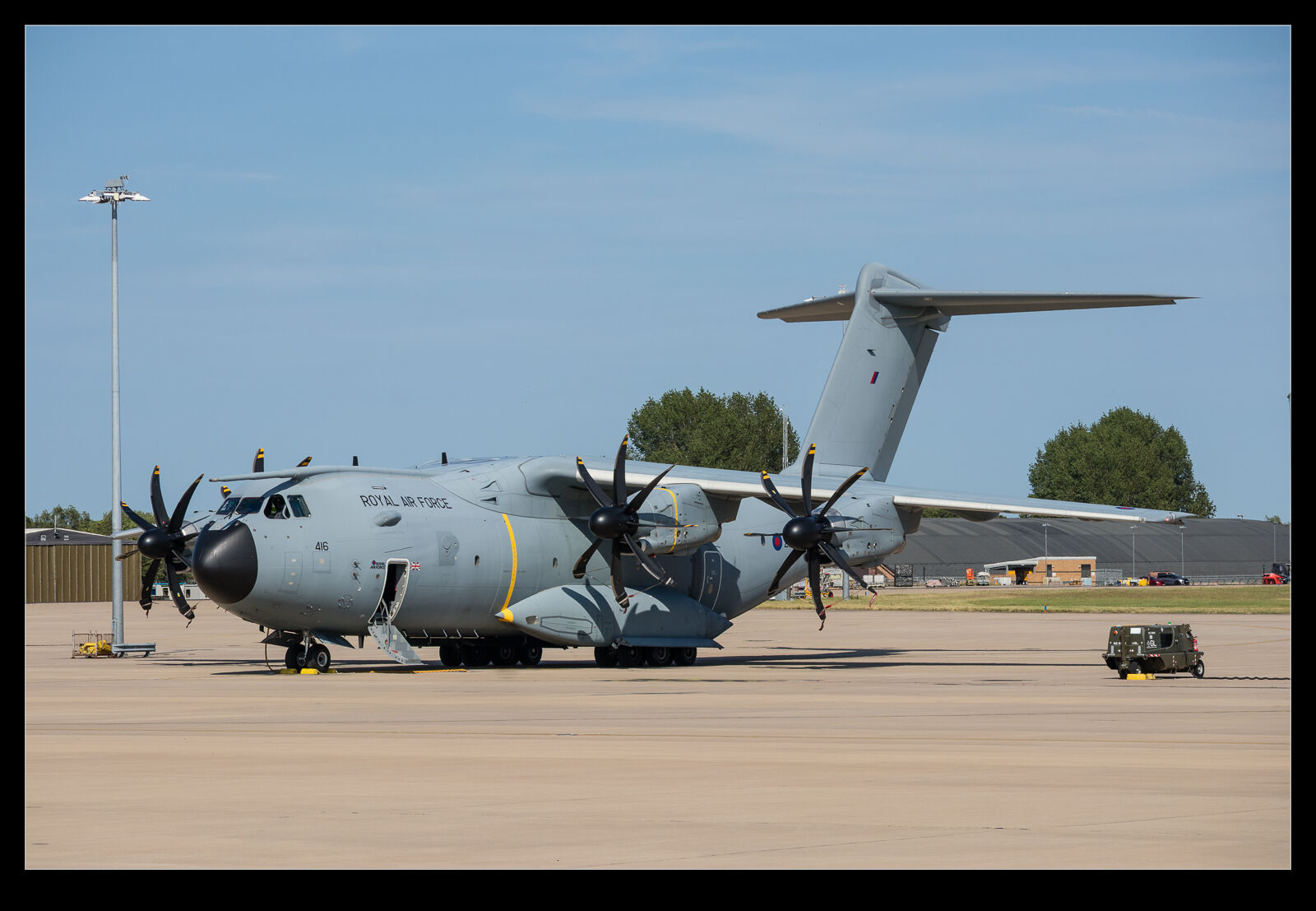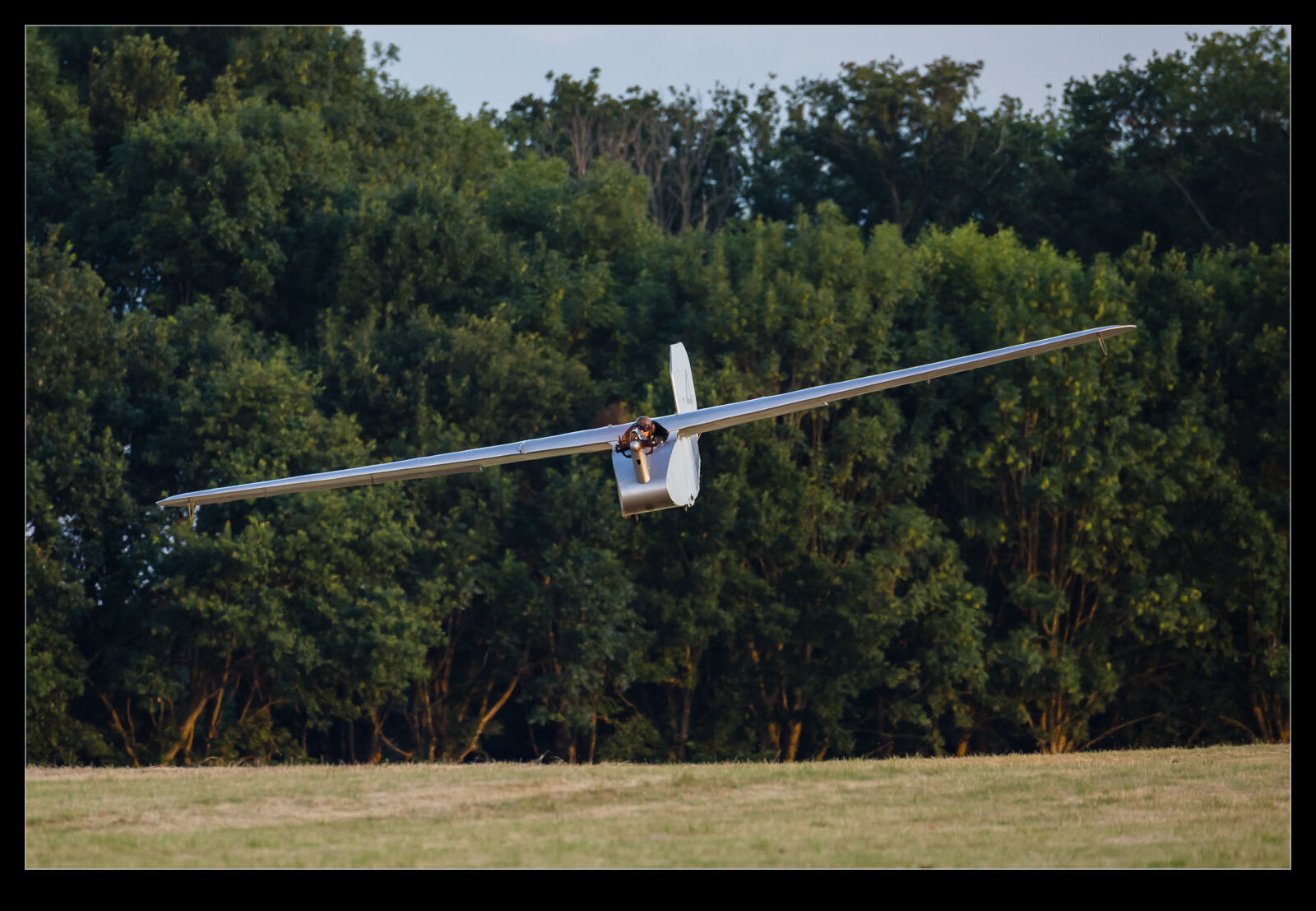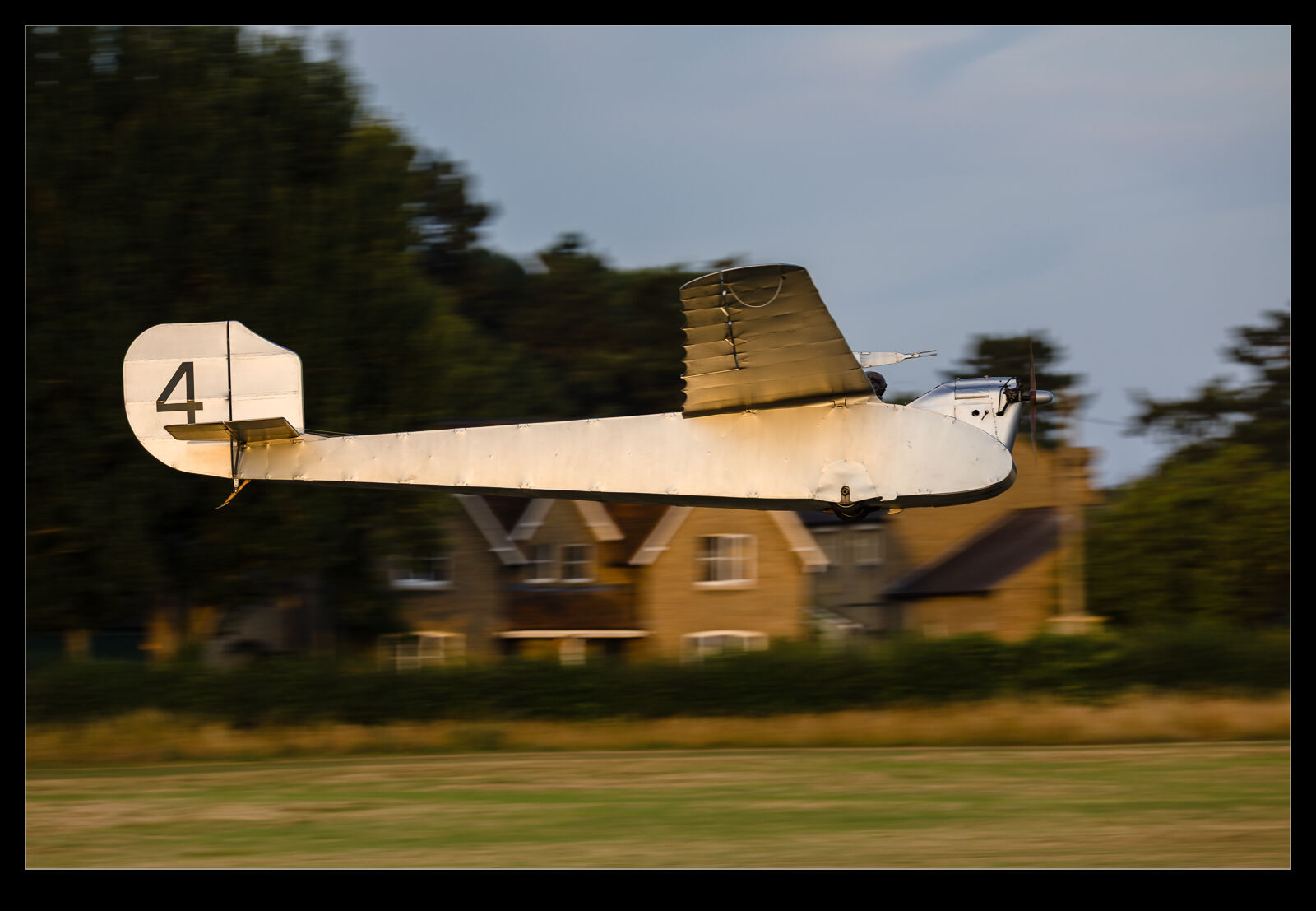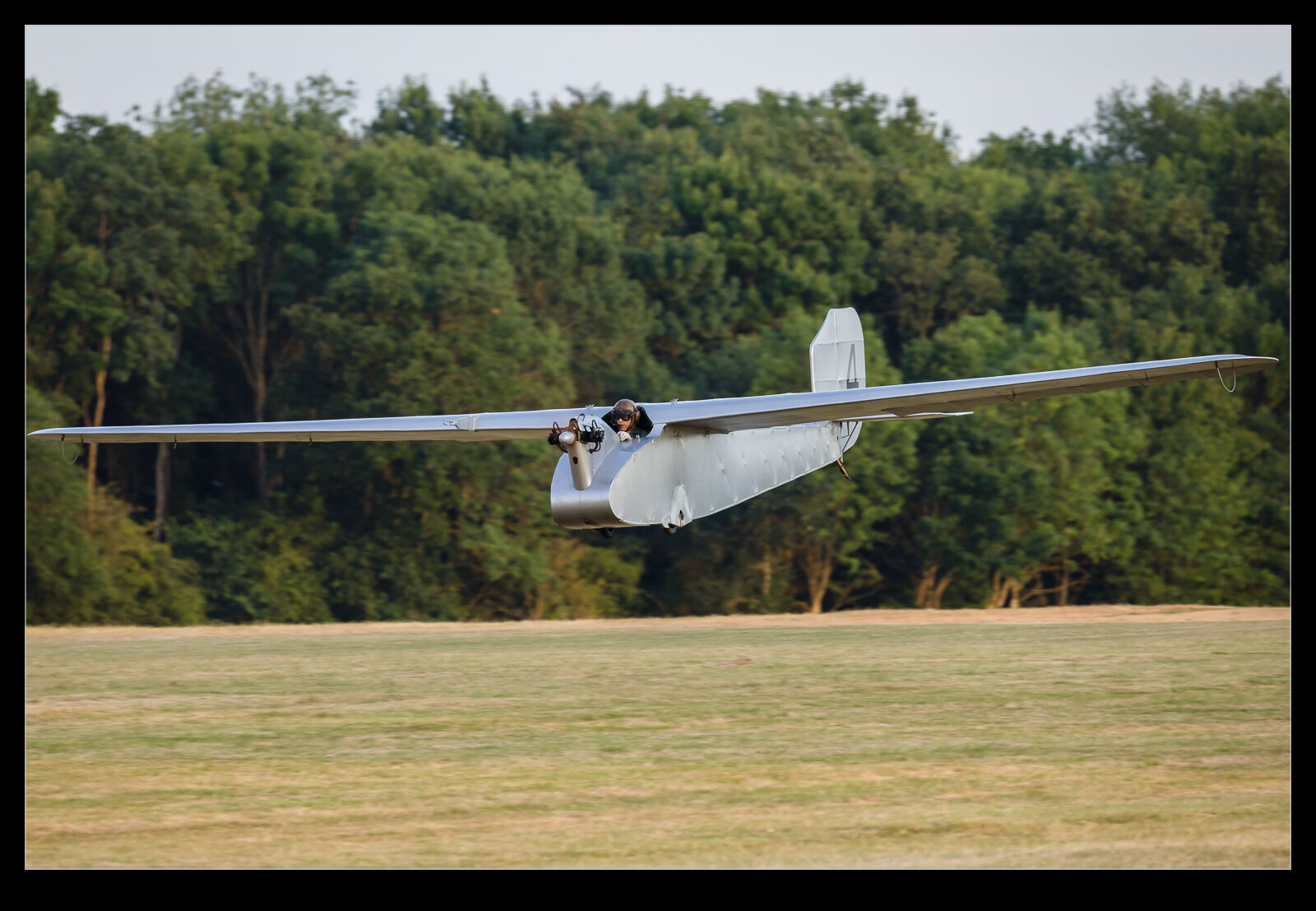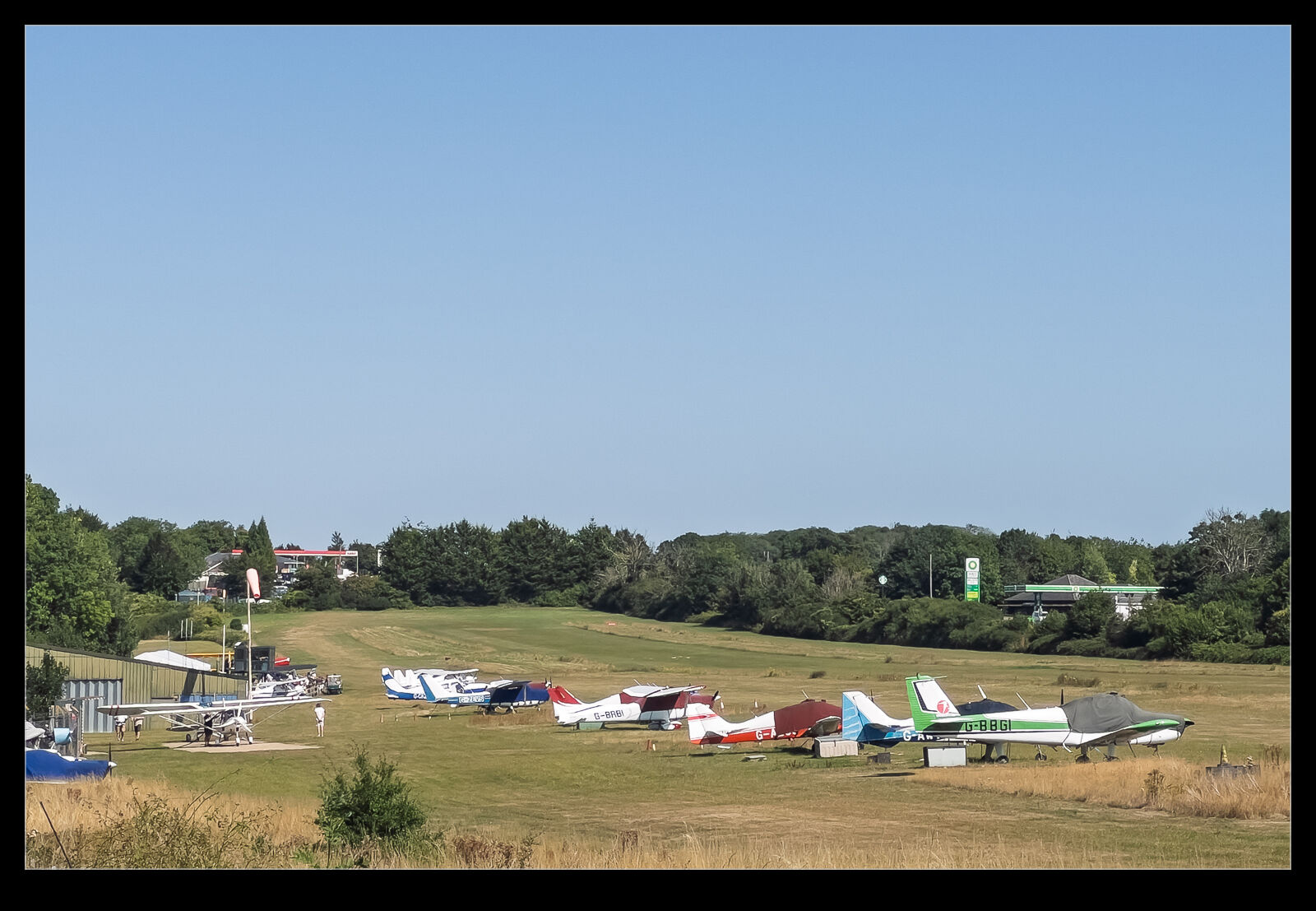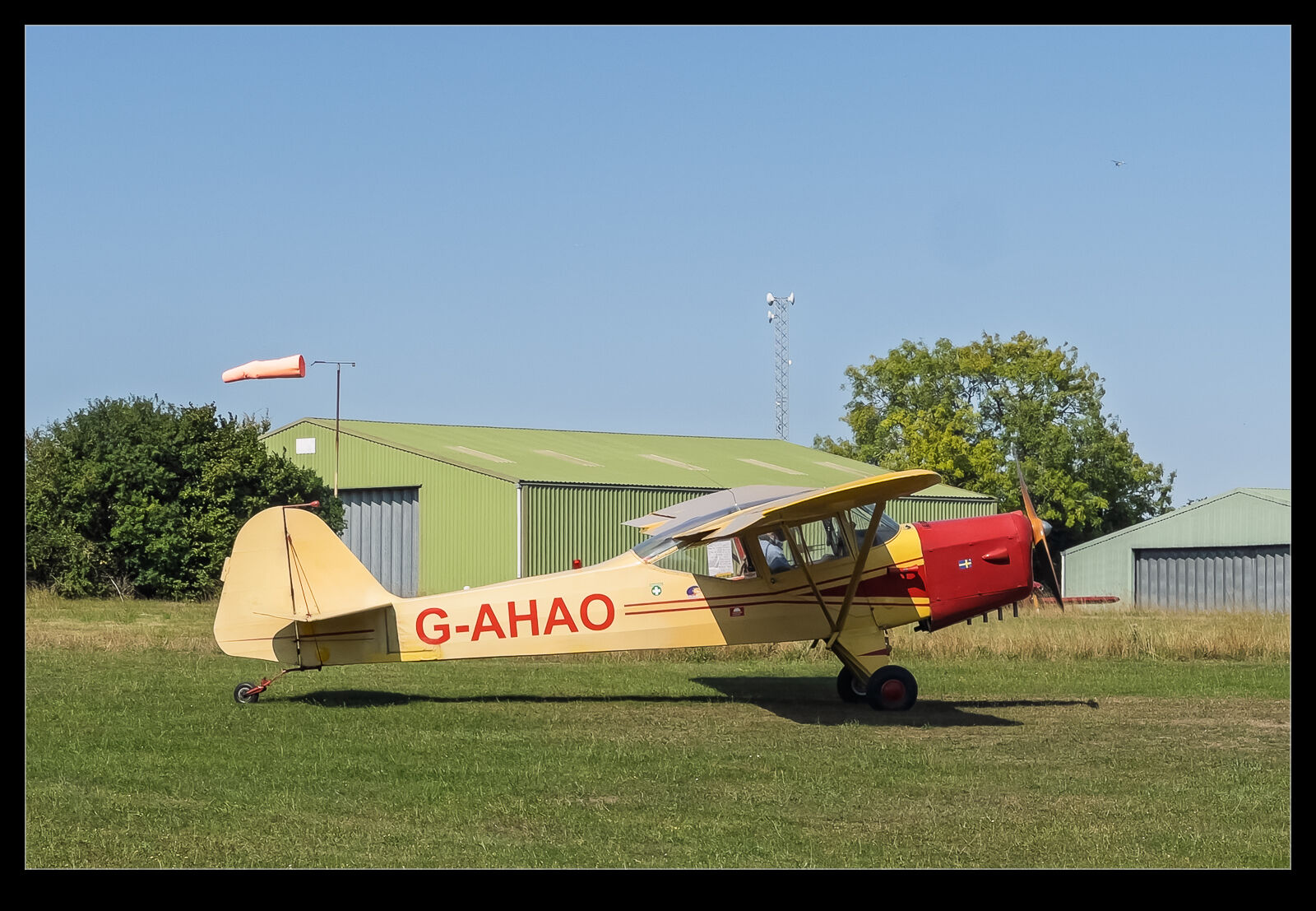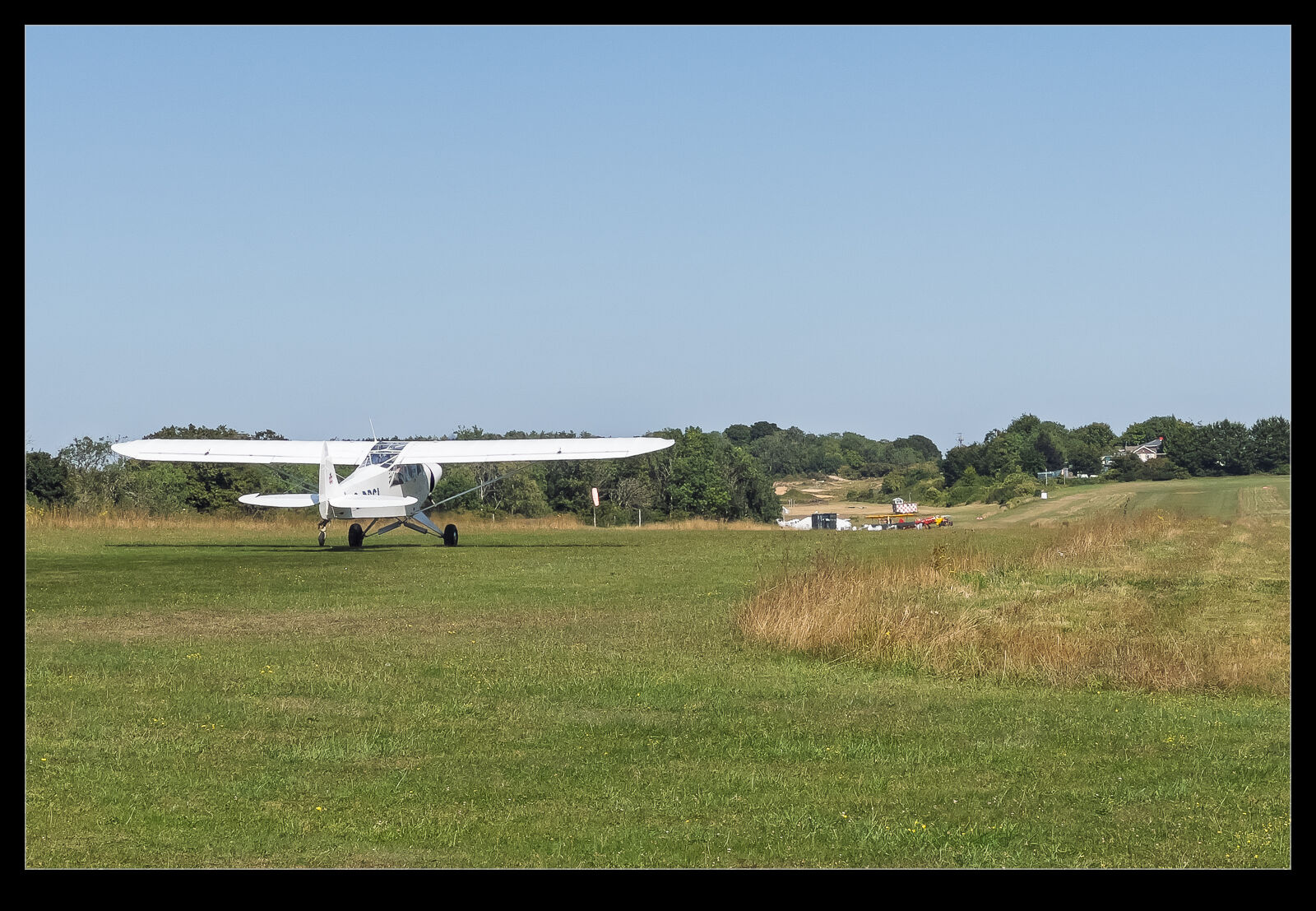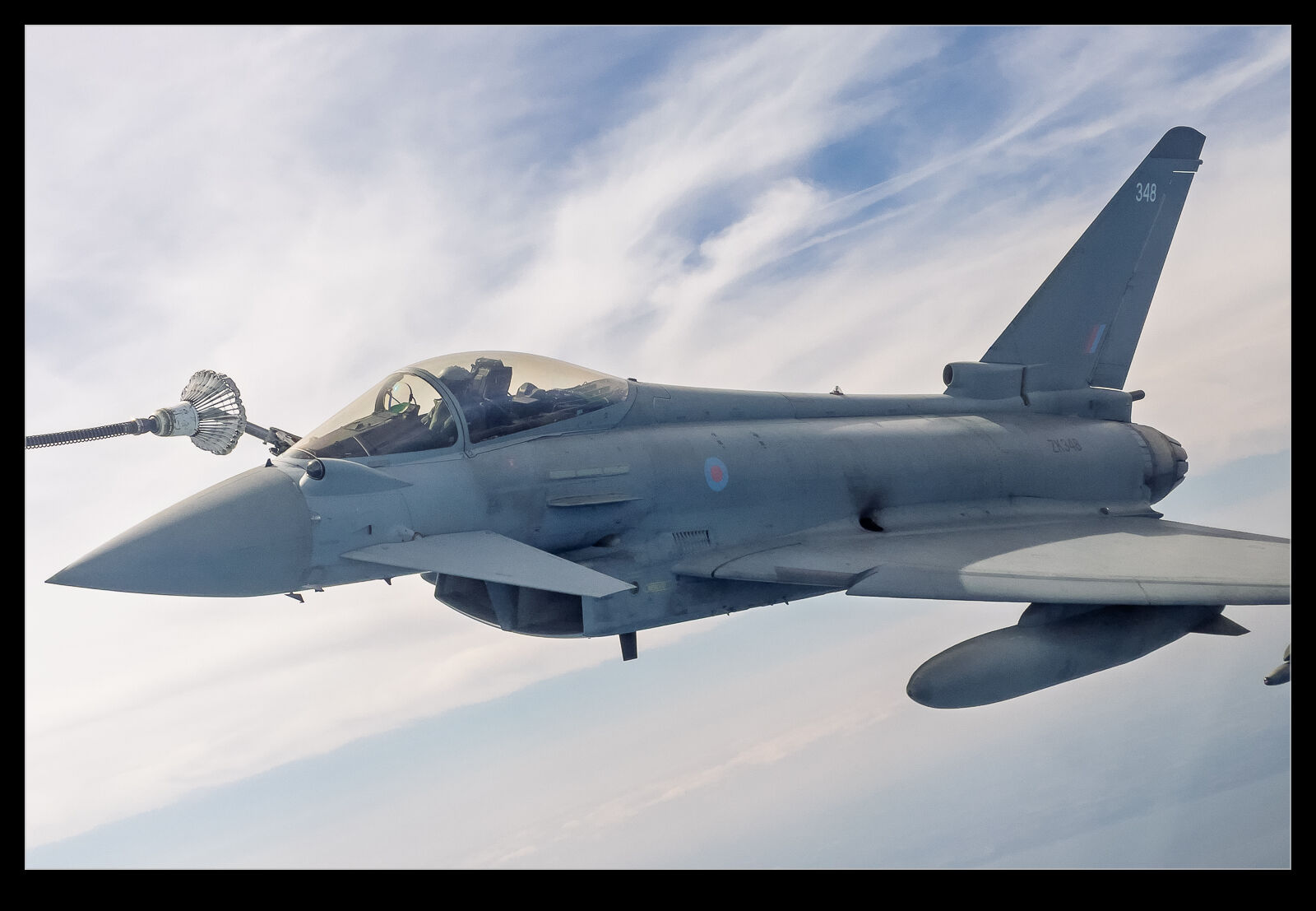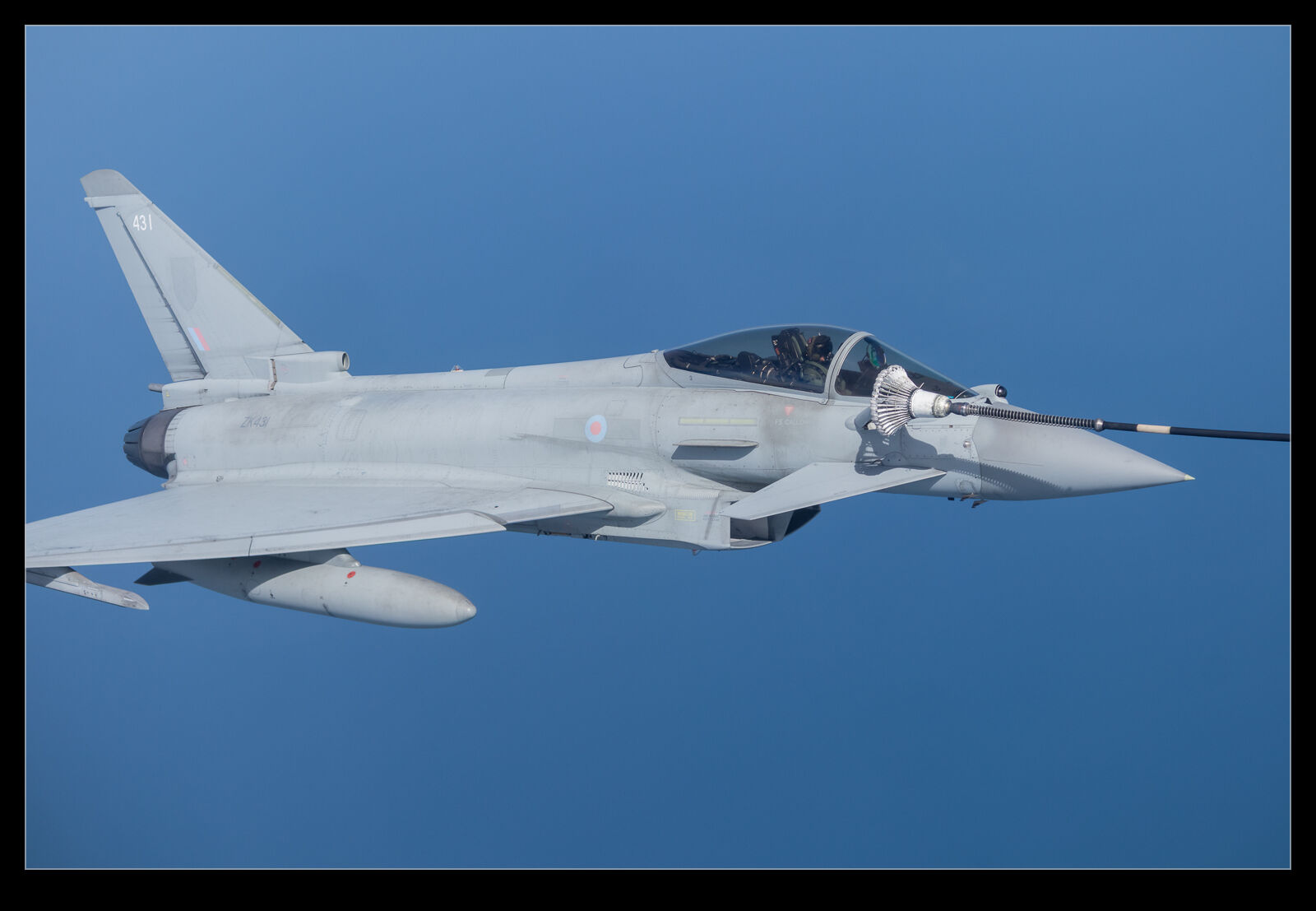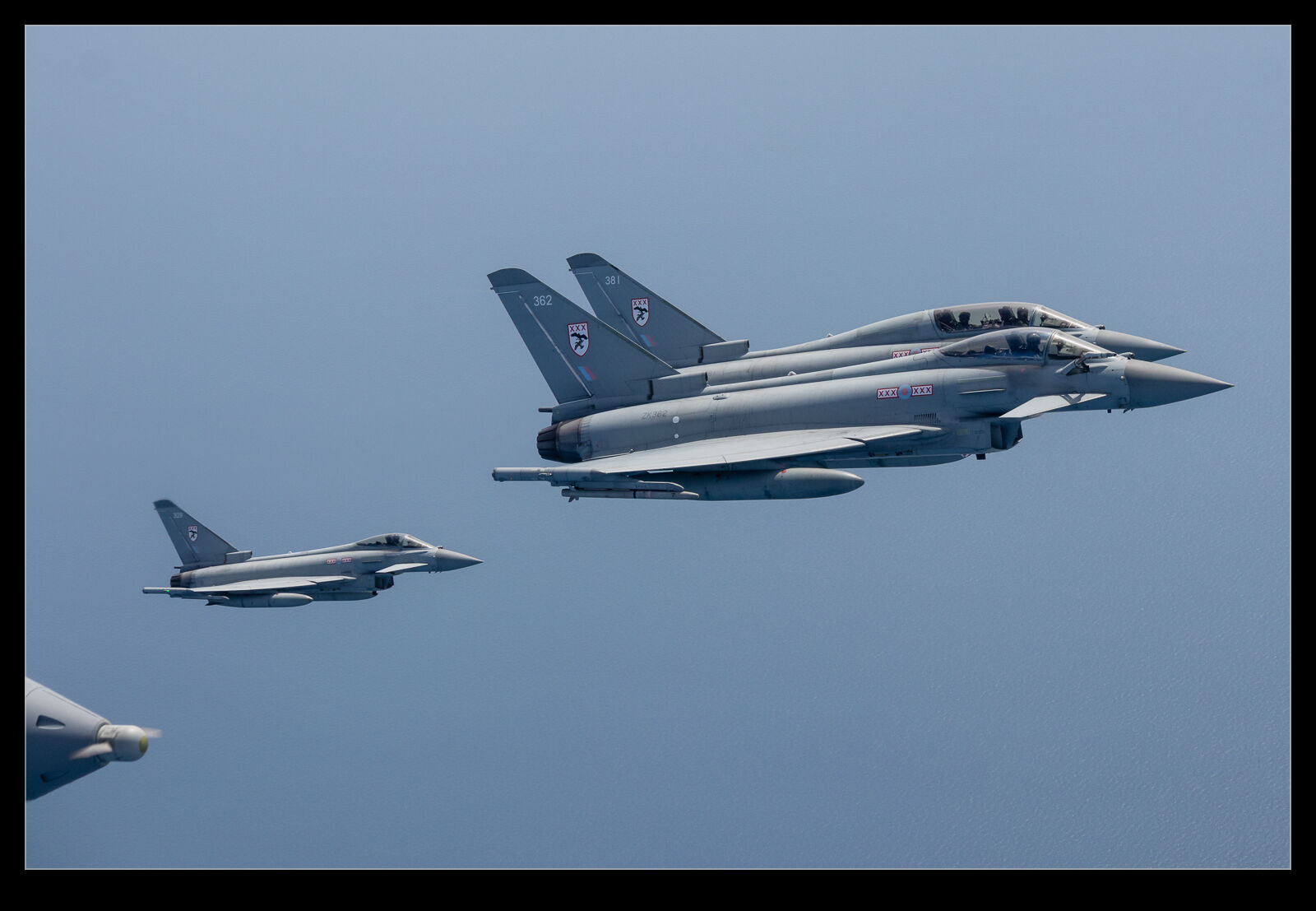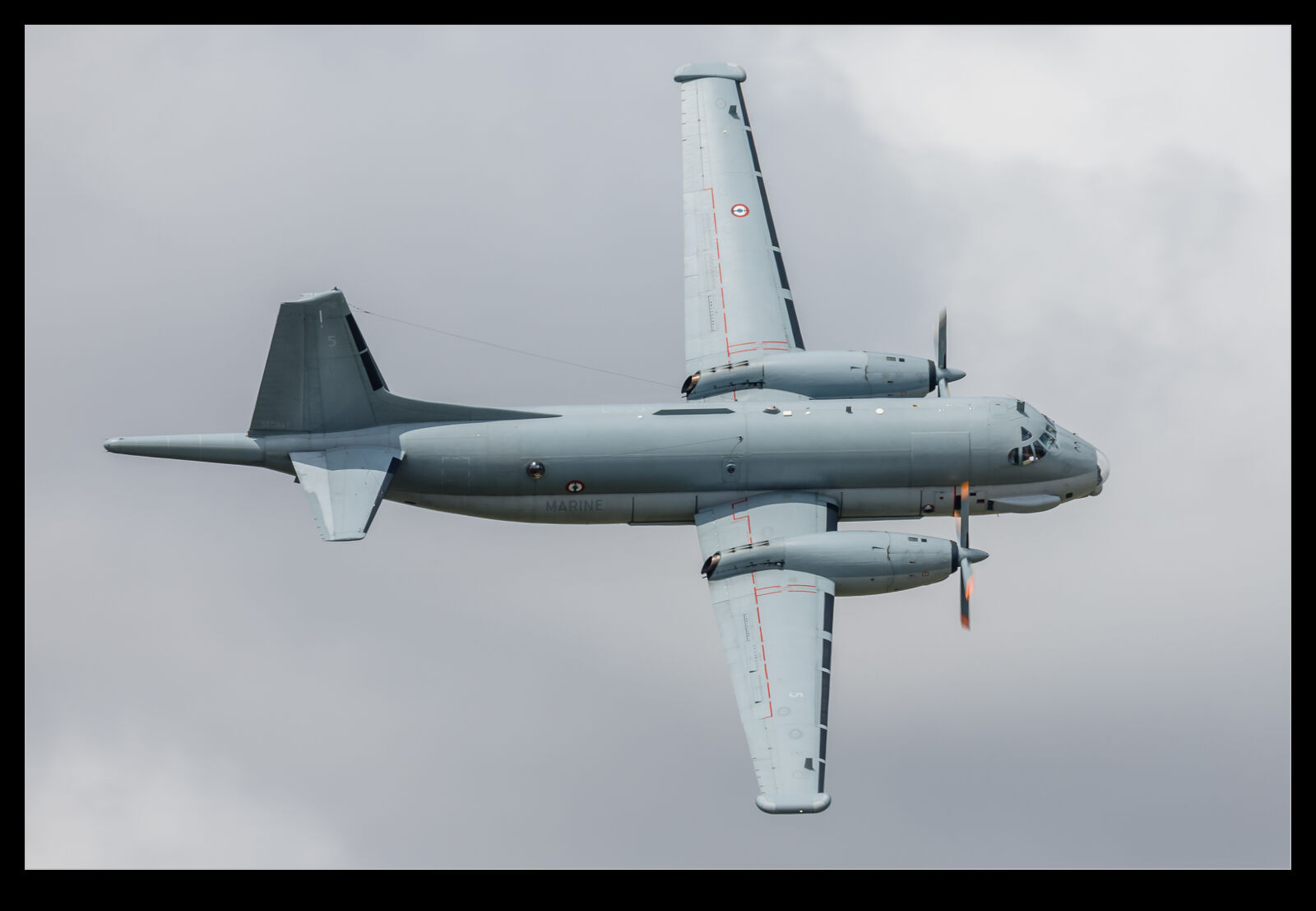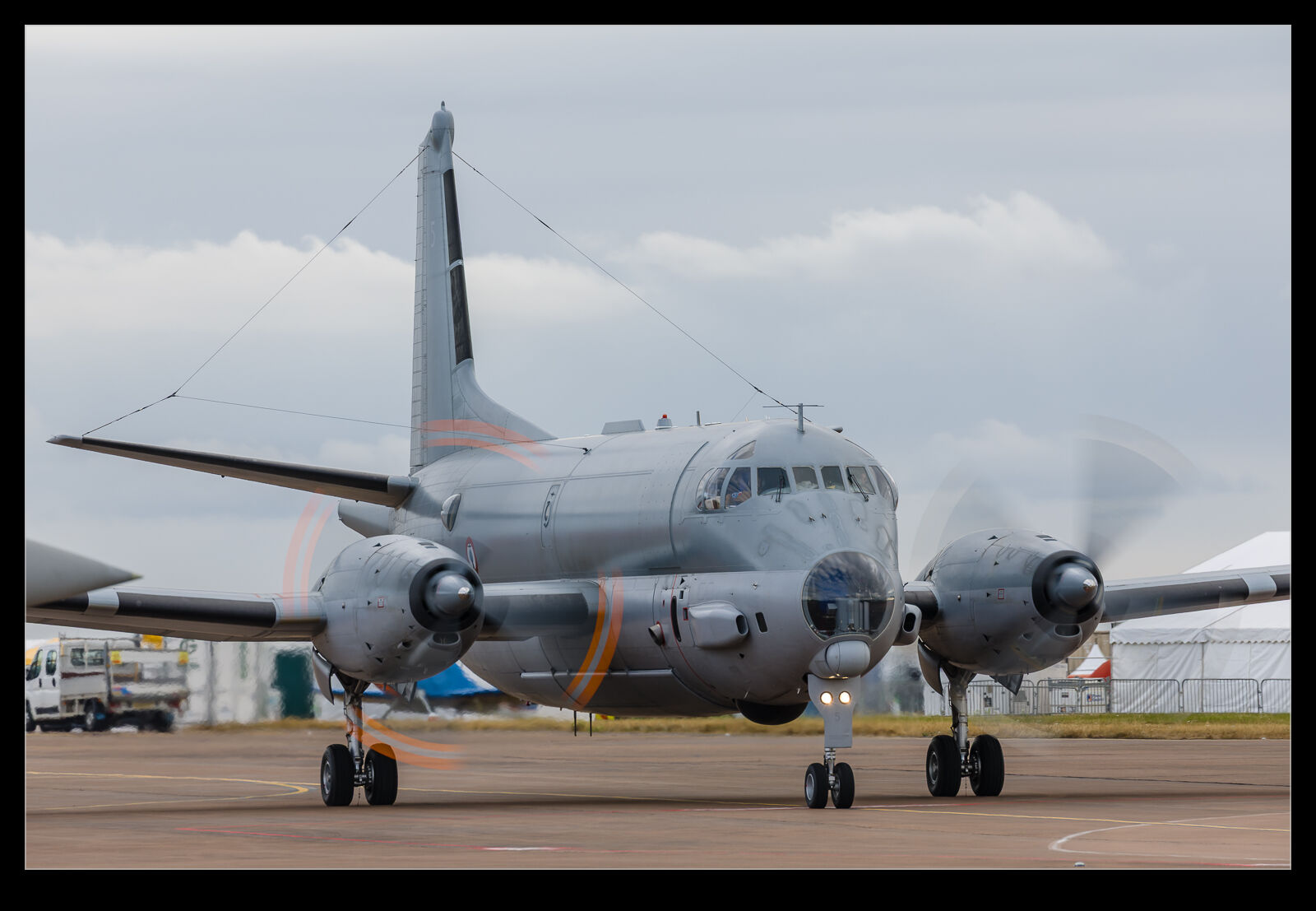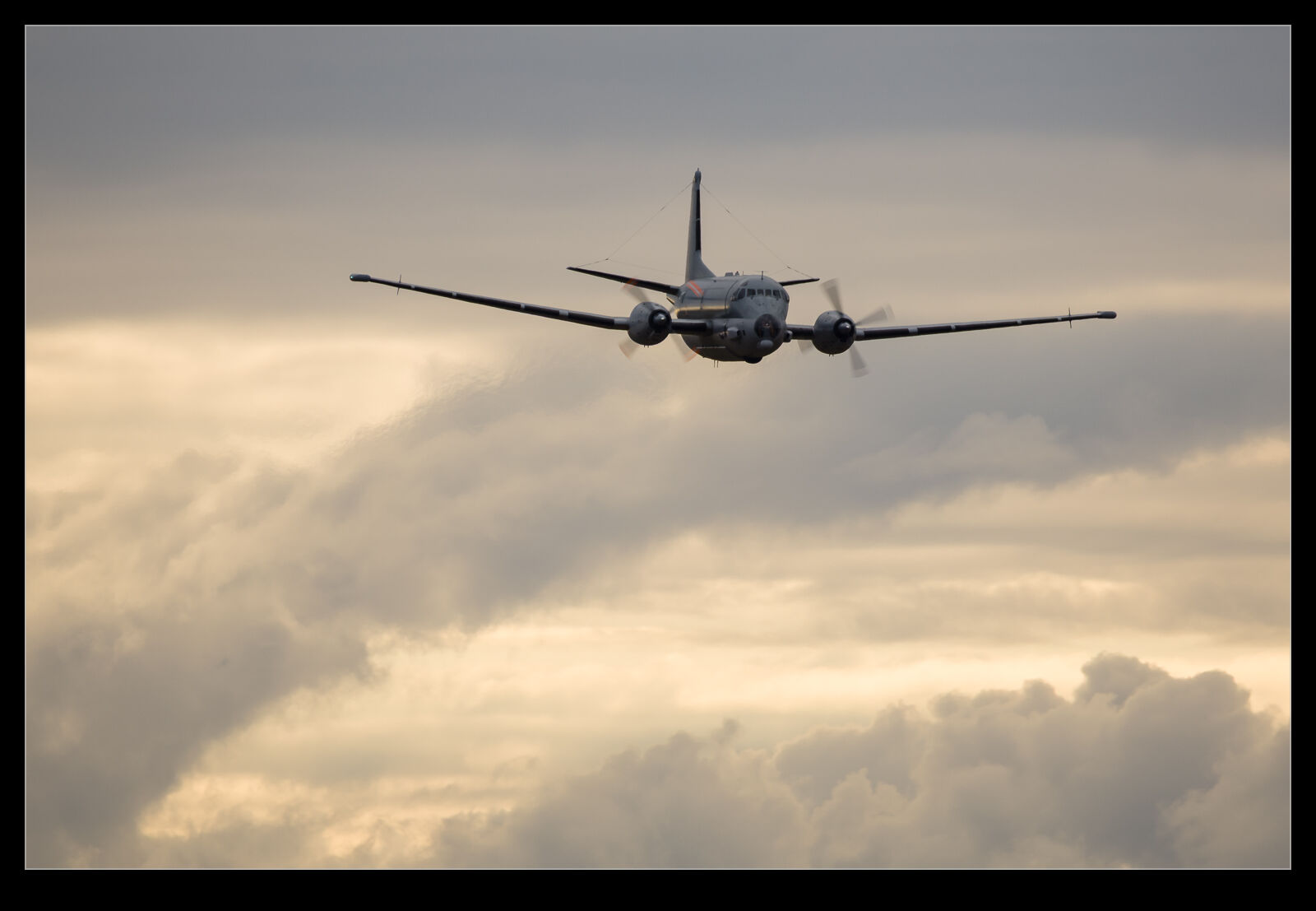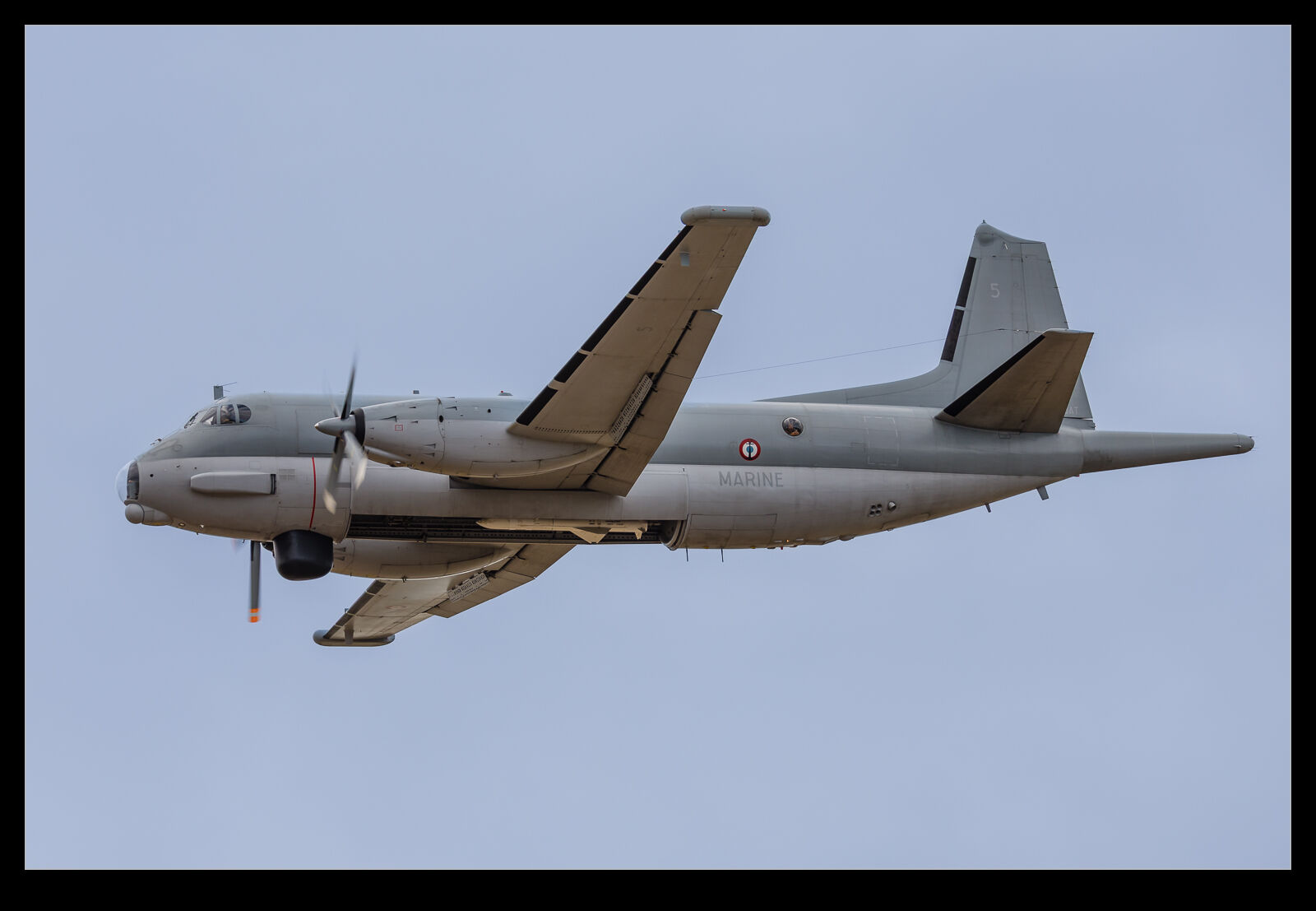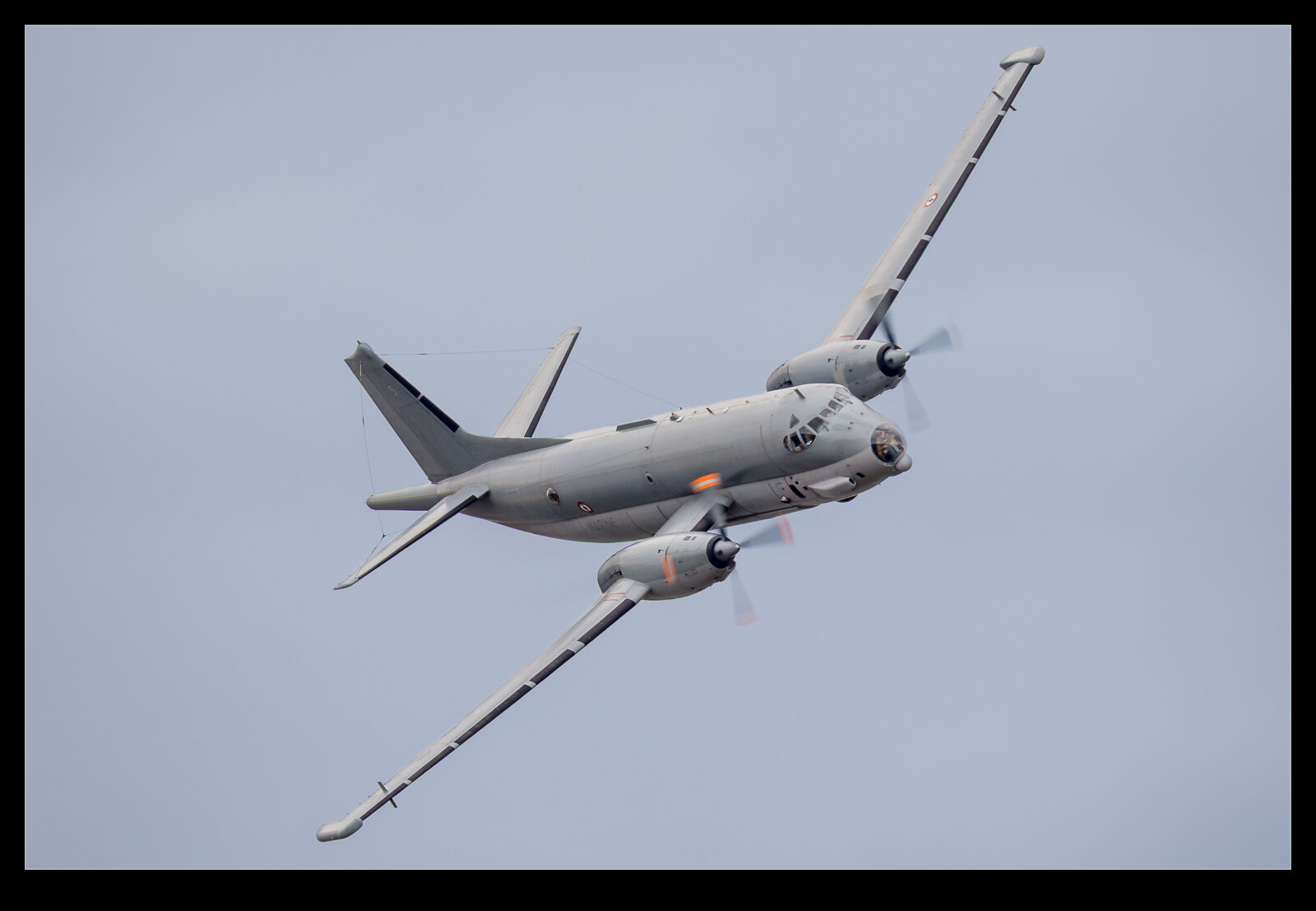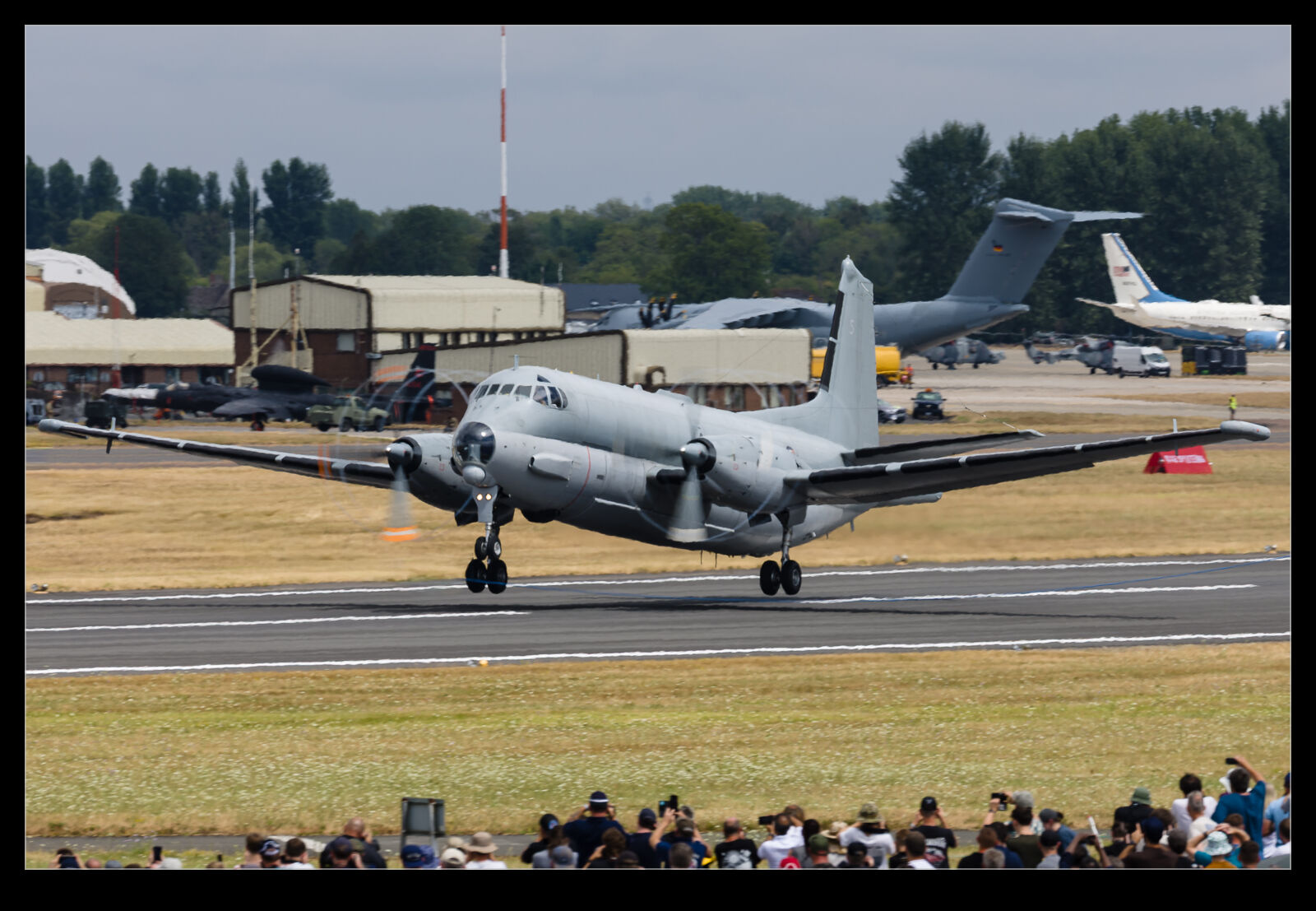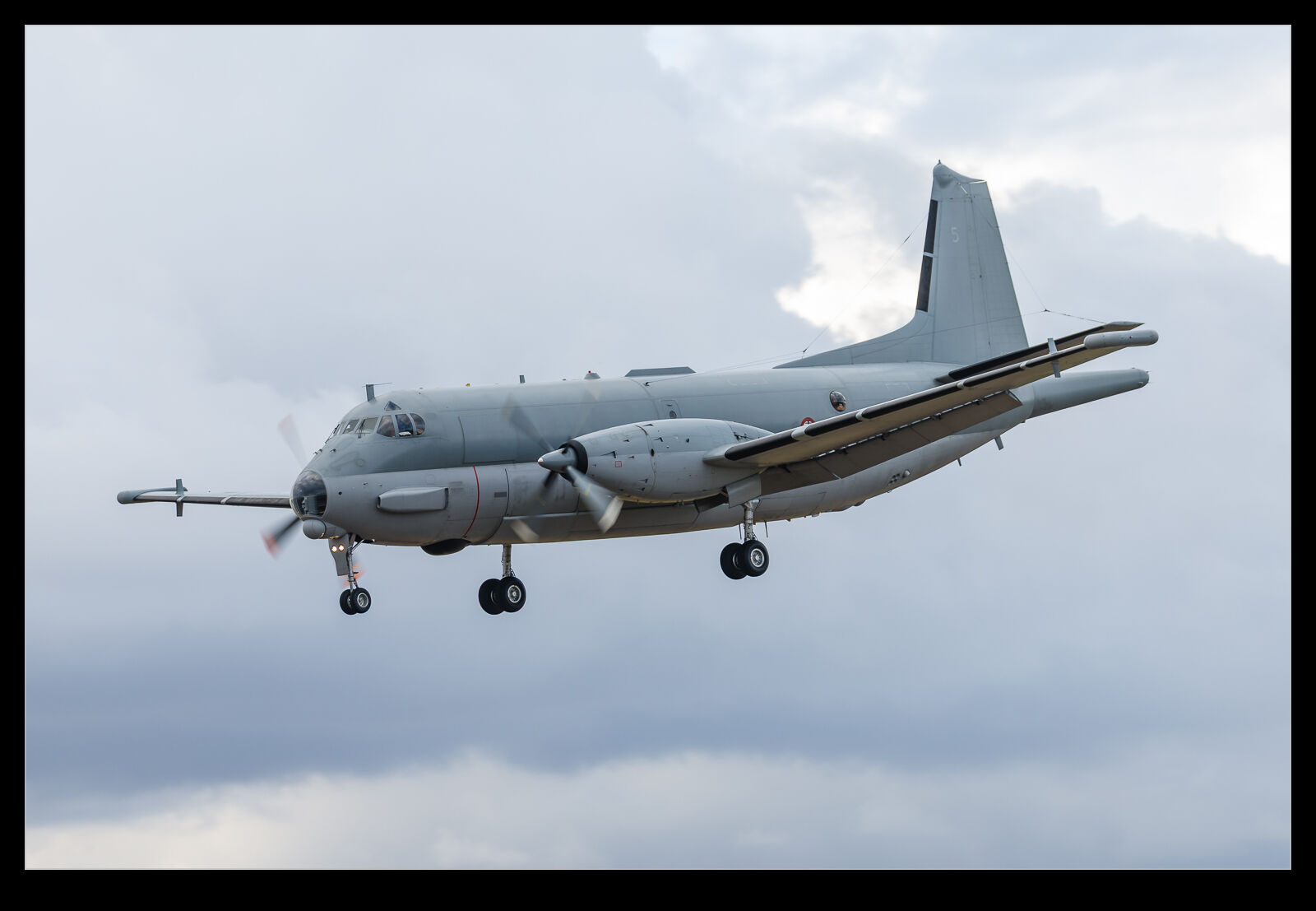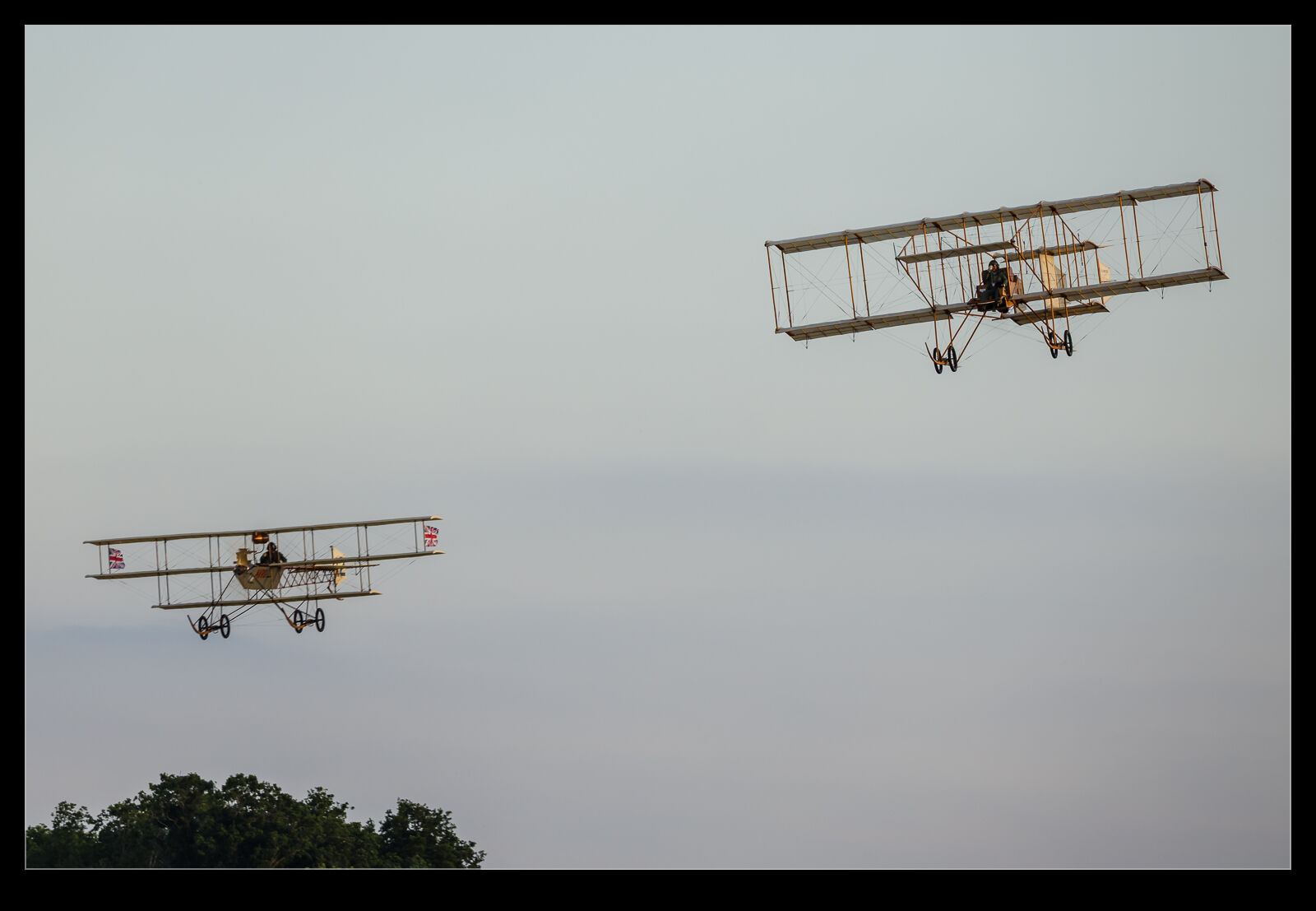 The great conditions for Shuttleworth’s Festival of Flight Sunday show meant we got to see a lot of the more fragile types fly. Later in this section of the show, we had the Bristol Boxkite and the Avro Triplane take to the sky. I know they are both replicas but that doesn’t make them any less rare or vulnerable. They flew around for quite a while and, since they are not speedy aircraft, they can keep it all close in front of the crowd. The light was definitely at its peak during their display. Here are a few shots of the two of them putting on a show.
The great conditions for Shuttleworth’s Festival of Flight Sunday show meant we got to see a lot of the more fragile types fly. Later in this section of the show, we had the Bristol Boxkite and the Avro Triplane take to the sky. I know they are both replicas but that doesn’t make them any less rare or vulnerable. They flew around for quite a while and, since they are not speedy aircraft, they can keep it all close in front of the crowd. The light was definitely at its peak during their display. Here are a few shots of the two of them putting on a show.
Tag Archives: airplane
A Hawk With Many Guises
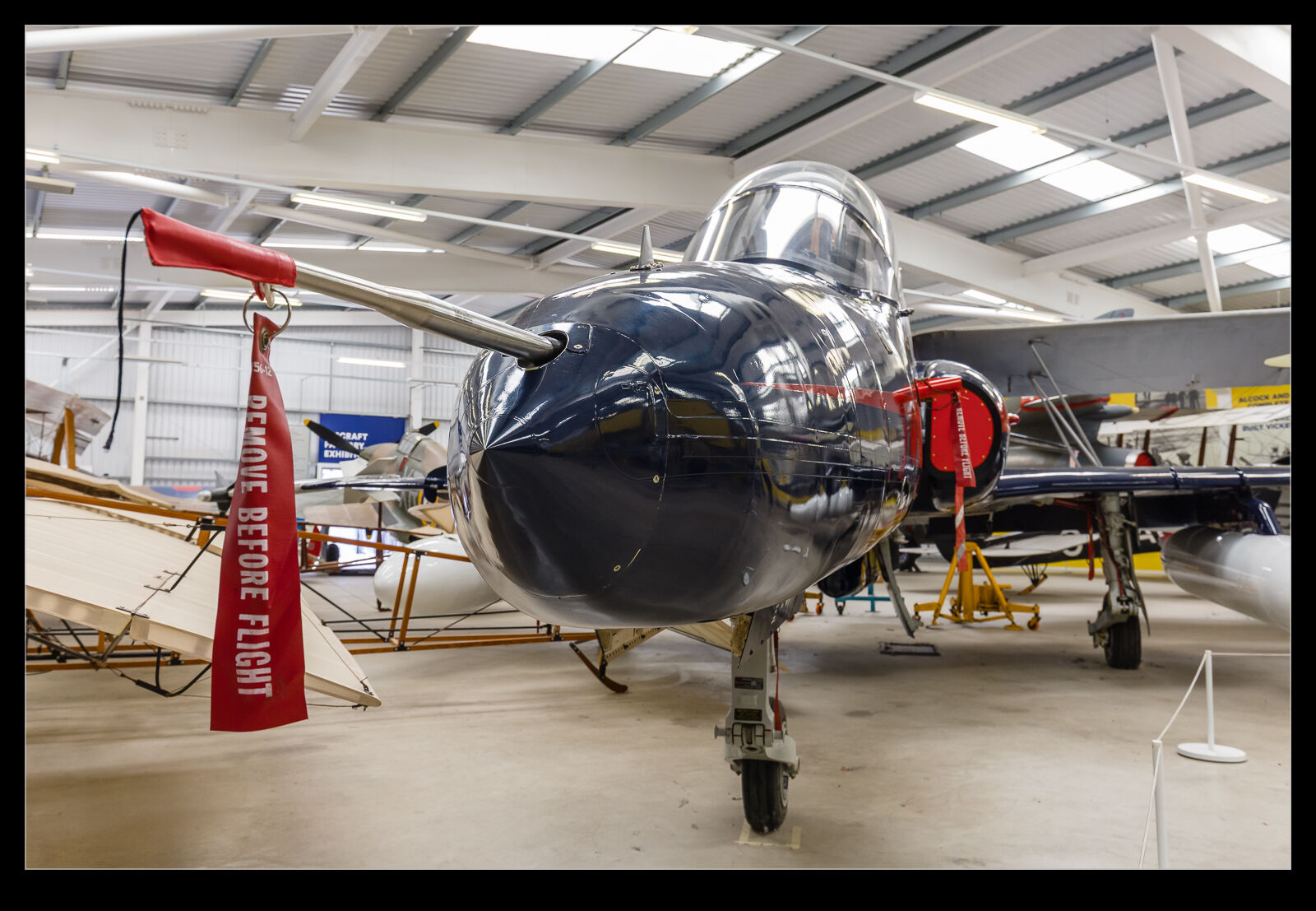 In the days when the old Hawker plant at Kingston/Dunsfold was still around, products like the Harrier and Hawk were generating plenty of revenue and opportunities. The company would build its own demonstrators for use outside the scope of the core client – the RAF. A Hawk airframe was company funded and it was registered G-HAWK. It was originally built as a 60 Series jet before having modifications to reflect the airframe shape of the 100 Series. It also had a COMA serial of ZA101 added at some point.
In the days when the old Hawker plant at Kingston/Dunsfold was still around, products like the Harrier and Hawk were generating plenty of revenue and opportunities. The company would build its own demonstrators for use outside the scope of the core client – the RAF. A Hawk airframe was company funded and it was registered G-HAWK. It was originally built as a 60 Series jet before having modifications to reflect the airframe shape of the 100 Series. It also had a COMA serial of ZA101 added at some point.
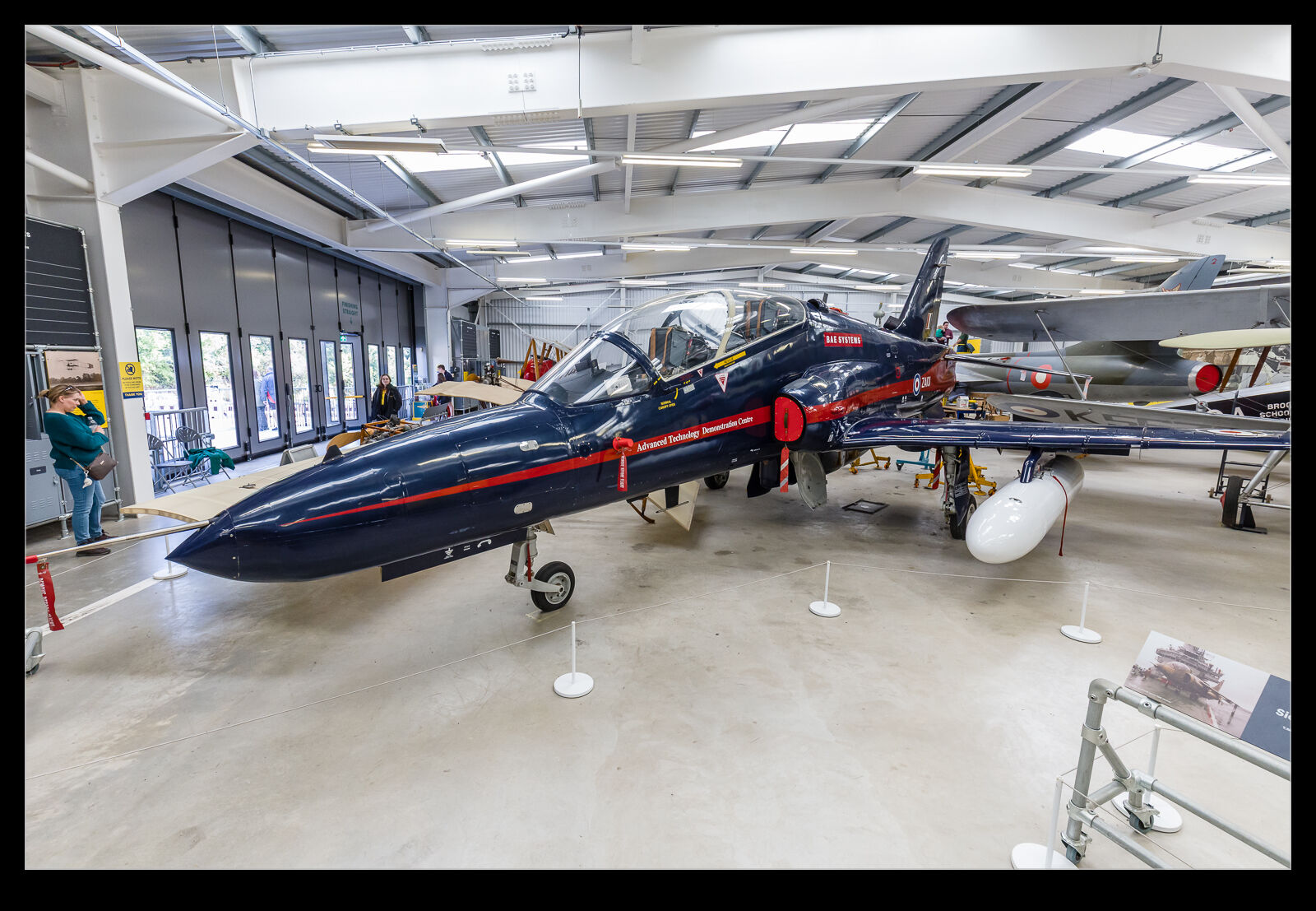 This aircraft moved to Warton when Dunsfold closed and continued to be used for all sorts of development work. I was long gone from Warton by the time its use ended. I was, therefore, pretty pleased to see it again at the Brooklands Museum. It is in the BAe house colours, but the nose is not a shape I recognise. I guess it did something interesting that needed another nose to be grafted on. I photographed this jet at various times over the years (although very little when I worked at Warton and could have seen it frequently!).
This aircraft moved to Warton when Dunsfold closed and continued to be used for all sorts of development work. I was long gone from Warton by the time its use ended. I was, therefore, pretty pleased to see it again at the Brooklands Museum. It is in the BAe house colours, but the nose is not a shape I recognise. I guess it did something interesting that needed another nose to be grafted on. I photographed this jet at various times over the years (although very little when I worked at Warton and could have seen it frequently!).
Before the Atlantique, There Was the Atlantic!
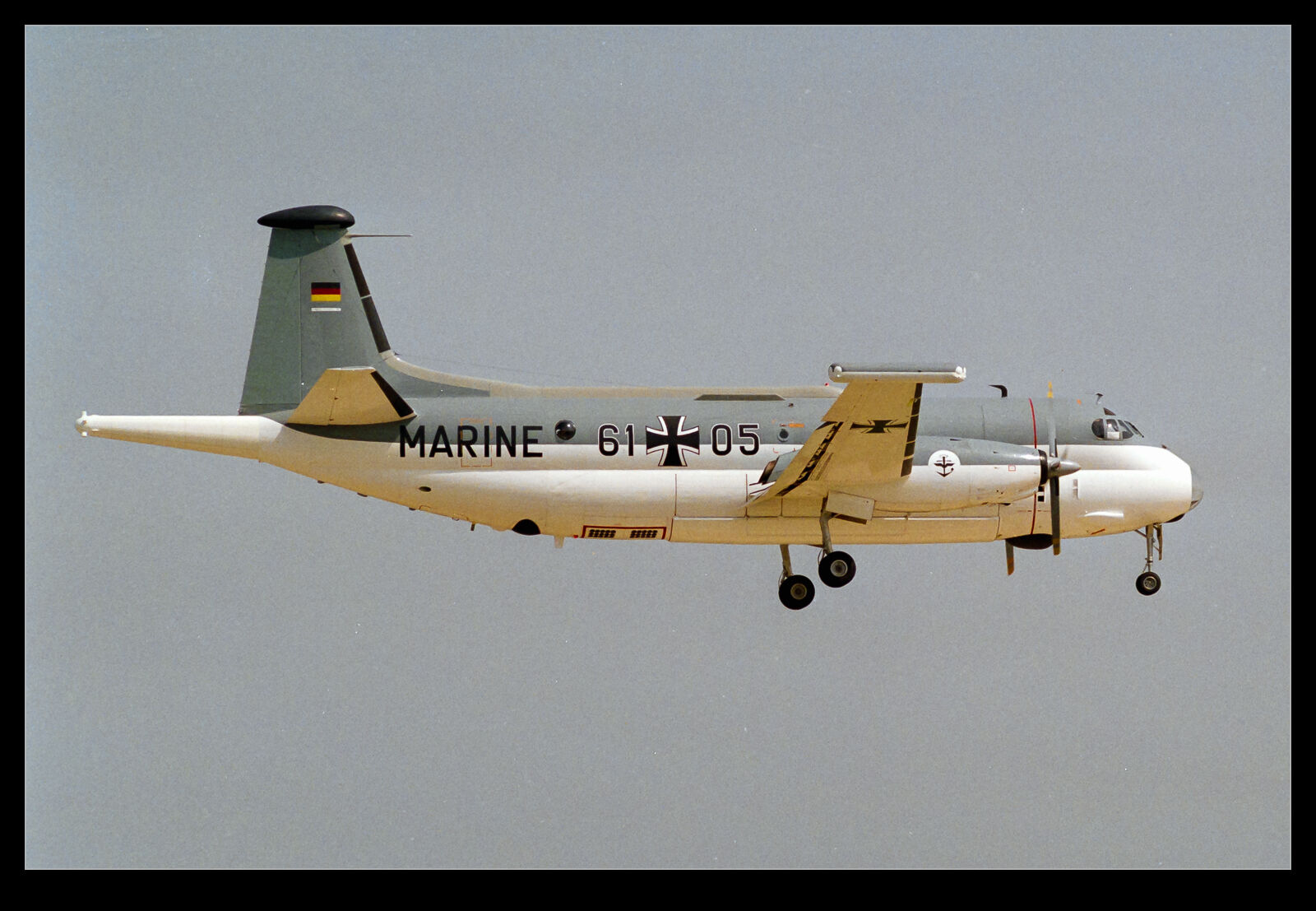 I posted recently with some shots of the Dassault Atlantique that was at RIAT. However, that got me thinking of the history of the Atlantique. It was actually an update to a previous generation plane. This was the Atlantic. Operated by France, Germany, Italy, the Netherlands and Pakistan, the Atlantic design was updated to create the Atlantique and the Atlantics were retired. I knew I had seen some of them for real and that was likely to be at Mildenhall when the Air Fete was able to attract a wide variety of operators and types. Turns out it was the French and German versions I got to see. Here are some shots of them.
I posted recently with some shots of the Dassault Atlantique that was at RIAT. However, that got me thinking of the history of the Atlantique. It was actually an update to a previous generation plane. This was the Atlantic. Operated by France, Germany, Italy, the Netherlands and Pakistan, the Atlantic design was updated to create the Atlantique and the Atlantics were retired. I knew I had seen some of them for real and that was likely to be at Mildenhall when the Air Fete was able to attract a wide variety of operators and types. Turns out it was the French and German versions I got to see. Here are some shots of them.
An E-3F For the First Time for Me
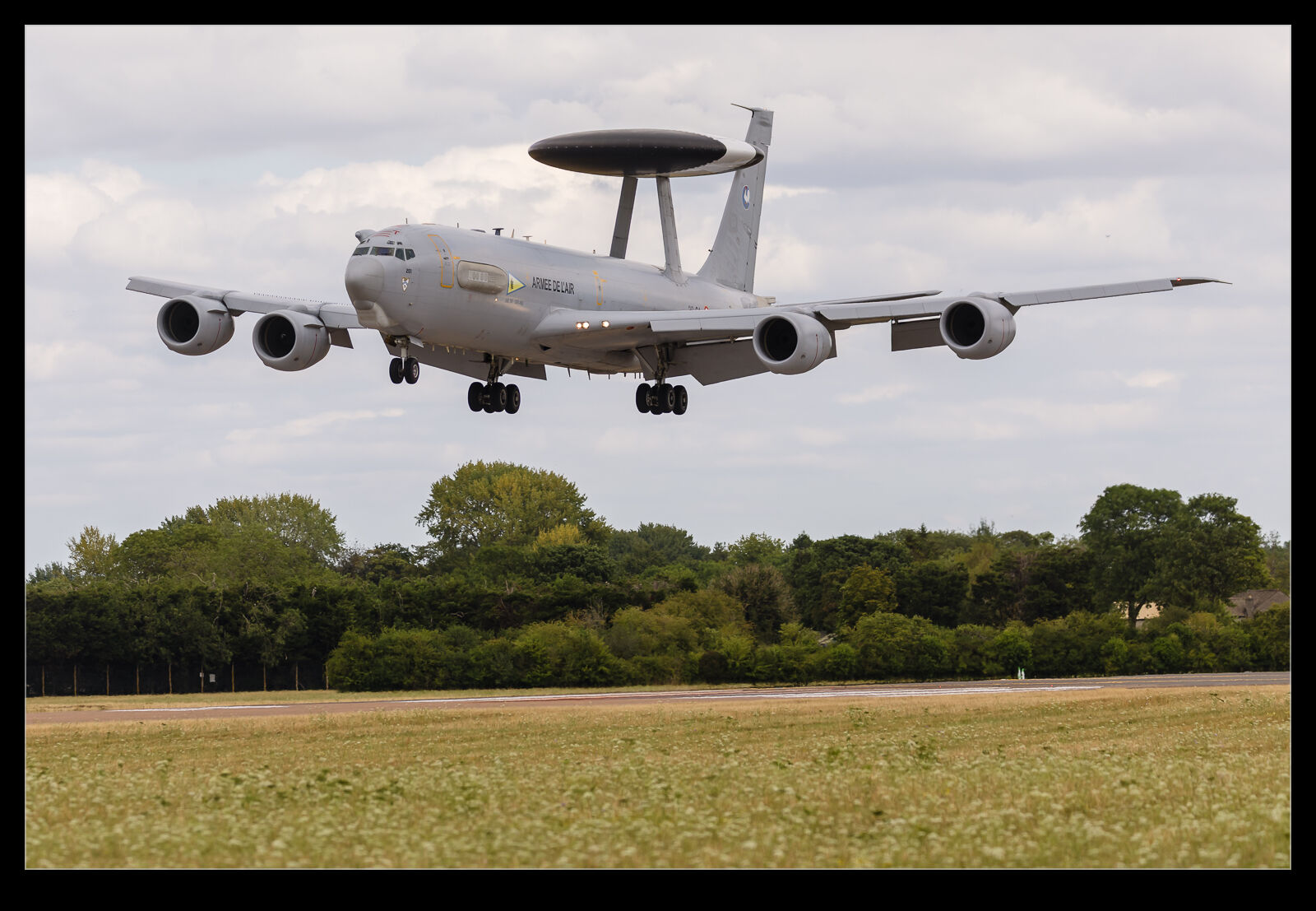 The early 90s had both the RAF and the French Air Force buying new airborne early warning aircraft in the form of the E-3. Unlike the USAF and NATO jets, these included the upgrade to the CFM56 engines which improved endurance and performance. I saw the RAF’s jets on many occasions but never encountered a French jet until this year – after the RAF jets have been retired and not long before the French ones follow suit. I’m not sure how much longer they have but seeing one arriving and departing the show was a nice result. I was pretty happy that I happened to be at the arrival end when it came in which was a bonus.
The early 90s had both the RAF and the French Air Force buying new airborne early warning aircraft in the form of the E-3. Unlike the USAF and NATO jets, these included the upgrade to the CFM56 engines which improved endurance and performance. I saw the RAF’s jets on many occasions but never encountered a French jet until this year – after the RAF jets have been retired and not long before the French ones follow suit. I’m not sure how much longer they have but seeing one arriving and departing the show was a nice result. I was pretty happy that I happened to be at the arrival end when it came in which was a bonus.
Rows of A400Ms
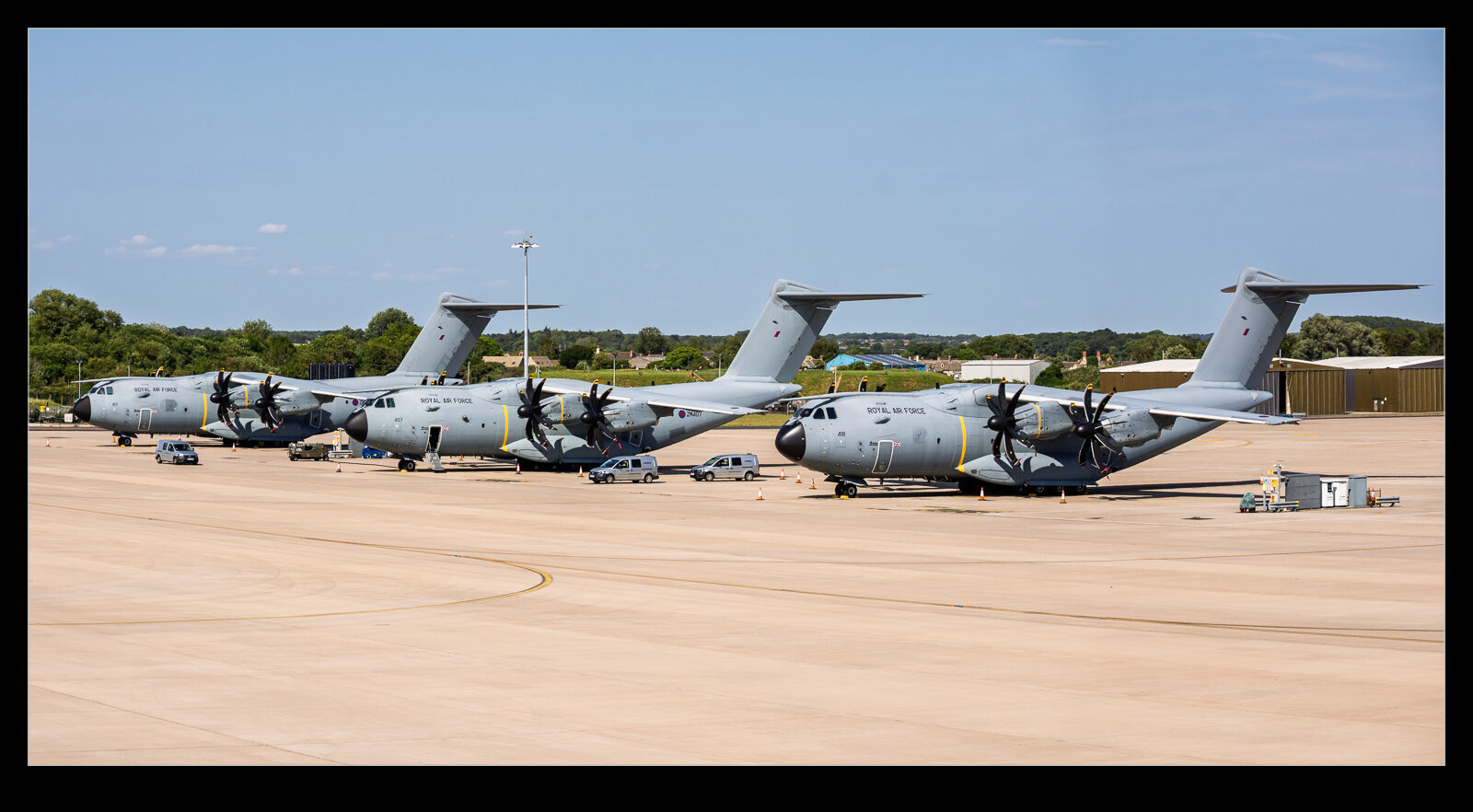 My visit to Brize Norton to have a trip with 101 Sqn wrapped up when we landed back at Brize. As we exited the aircraft and waited on the ramp to get some group photos, we were surrounded by other aircraft. More Voyagers were lined up but there were plenty of A400M Atlas transports ready for their next mission. It was a pleasant afternoon with nice light on the planes so I grabbed a few shots of the planes before we gathered for our group photo.
My visit to Brize Norton to have a trip with 101 Sqn wrapped up when we landed back at Brize. As we exited the aircraft and waited on the ramp to get some group photos, we were surrounded by other aircraft. More Voyagers were lined up but there were plenty of A400M Atlas transports ready for their next mission. It was a pleasant afternoon with nice light on the planes so I grabbed a few shots of the planes before we gathered for our group photo.
This is Not a Canberra or a Lightning!
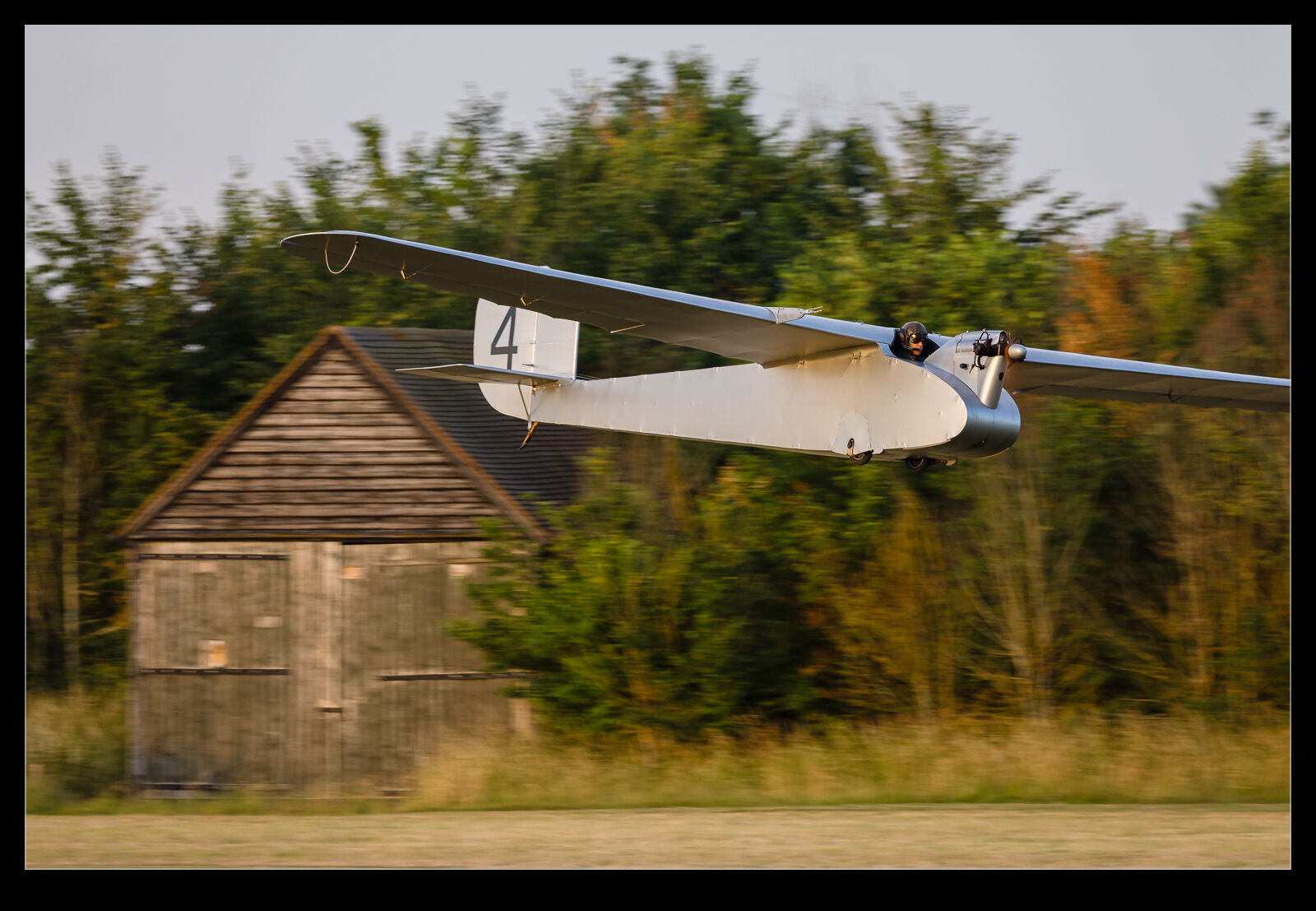 The name English Electric is well known in aviation circles. Before it was subsumed into the British Aircraft Corporation, it had produced the Lightning interceptor and the Canberra bomber. The Lightning might have got more glory, but the Canberra was by far the more successful type with excellent performance. However, there is a lesser-known type that came from the company a long time before.
The name English Electric is well known in aviation circles. Before it was subsumed into the British Aircraft Corporation, it had produced the Lightning interceptor and the Canberra bomber. The Lightning might have got more glory, but the Canberra was by far the more successful type with excellent performance. However, there is a lesser-known type that came from the company a long time before.
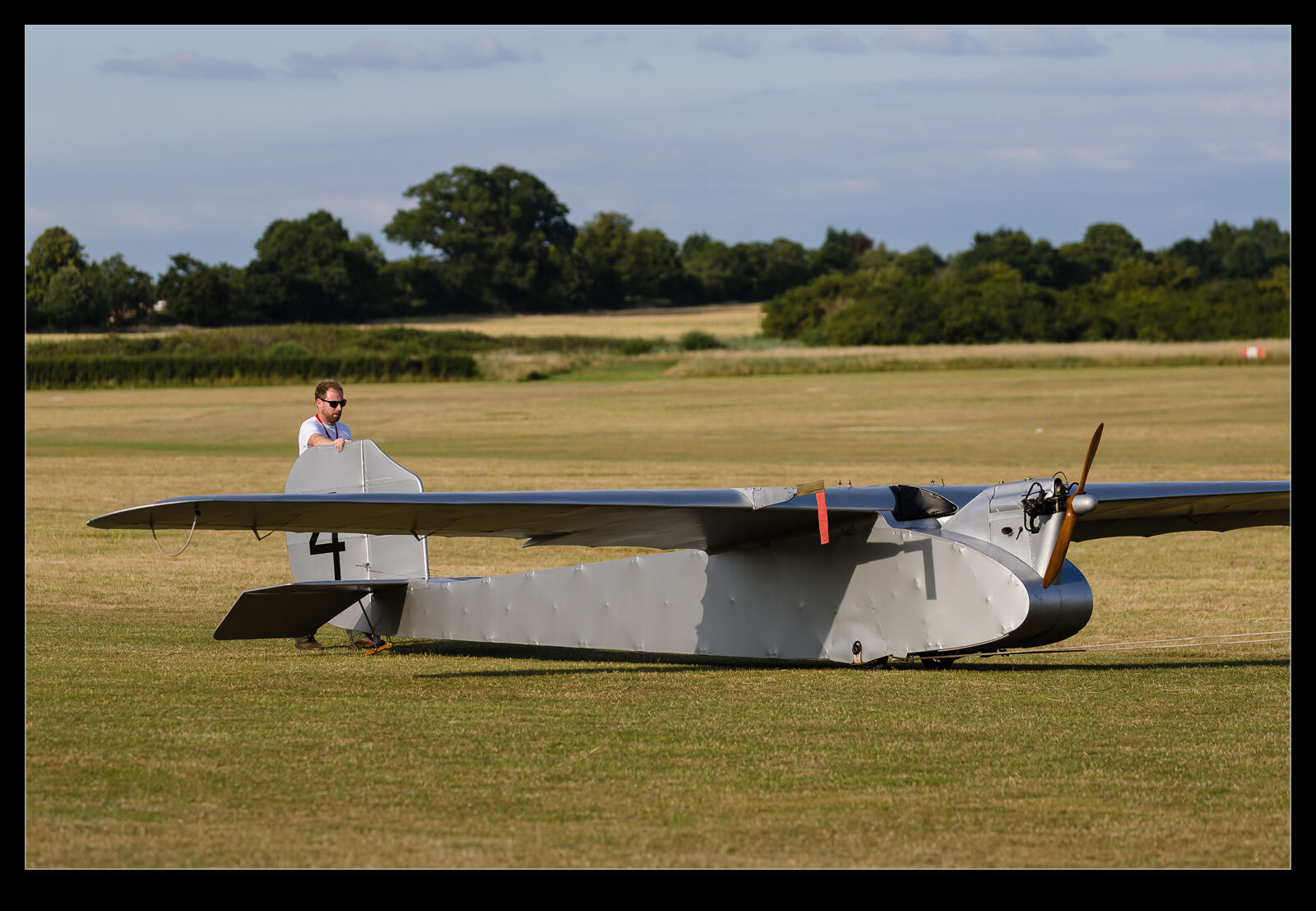 I first heard of the Wren when I read about it in Roly Beamont’s book. He was the chief test pilot at English Electric, and he described this vintage aircraft with very limited power that the company restored and hopped along the runway at Warton many years before I worked there. The aircraft now lives at Old Warden and it was brought out to fly during the Shuttleworth Festival of Flight. It was towed up to the far end of the field in preparation for its flight. The conditions were smooth, so it was going to be able to perform.
I first heard of the Wren when I read about it in Roly Beamont’s book. He was the chief test pilot at English Electric, and he described this vintage aircraft with very limited power that the company restored and hopped along the runway at Warton many years before I worked there. The aircraft now lives at Old Warden and it was brought out to fly during the Shuttleworth Festival of Flight. It was towed up to the far end of the field in preparation for its flight. The conditions were smooth, so it was going to be able to perform.
 Having read that it was not over-endowed with power and that the Warton tests had involved some basic hops along the runway, this was what I had anticipated would be the case here. However, they were more ambitious. After flying the length of the field, a turn was made for a return run. I have to admit, when I first saw the turn, I did fear that all was not well. The whole flight was at low level, so the turn was also low. The angle made it look like the plane was heading for the trees. However, this was quite normal and in control. Even so, every turn made me tense up slightly. I guess by the end of the flight, I was getting used to it. Even so, it was quite unlike most flying I have watched.
Having read that it was not over-endowed with power and that the Warton tests had involved some basic hops along the runway, this was what I had anticipated would be the case here. However, they were more ambitious. After flying the length of the field, a turn was made for a return run. I have to admit, when I first saw the turn, I did fear that all was not well. The whole flight was at low level, so the turn was also low. The angle made it look like the plane was heading for the trees. However, this was quite normal and in control. Even so, every turn made me tense up slightly. I guess by the end of the flight, I was getting used to it. Even so, it was quite unlike most flying I have watched.
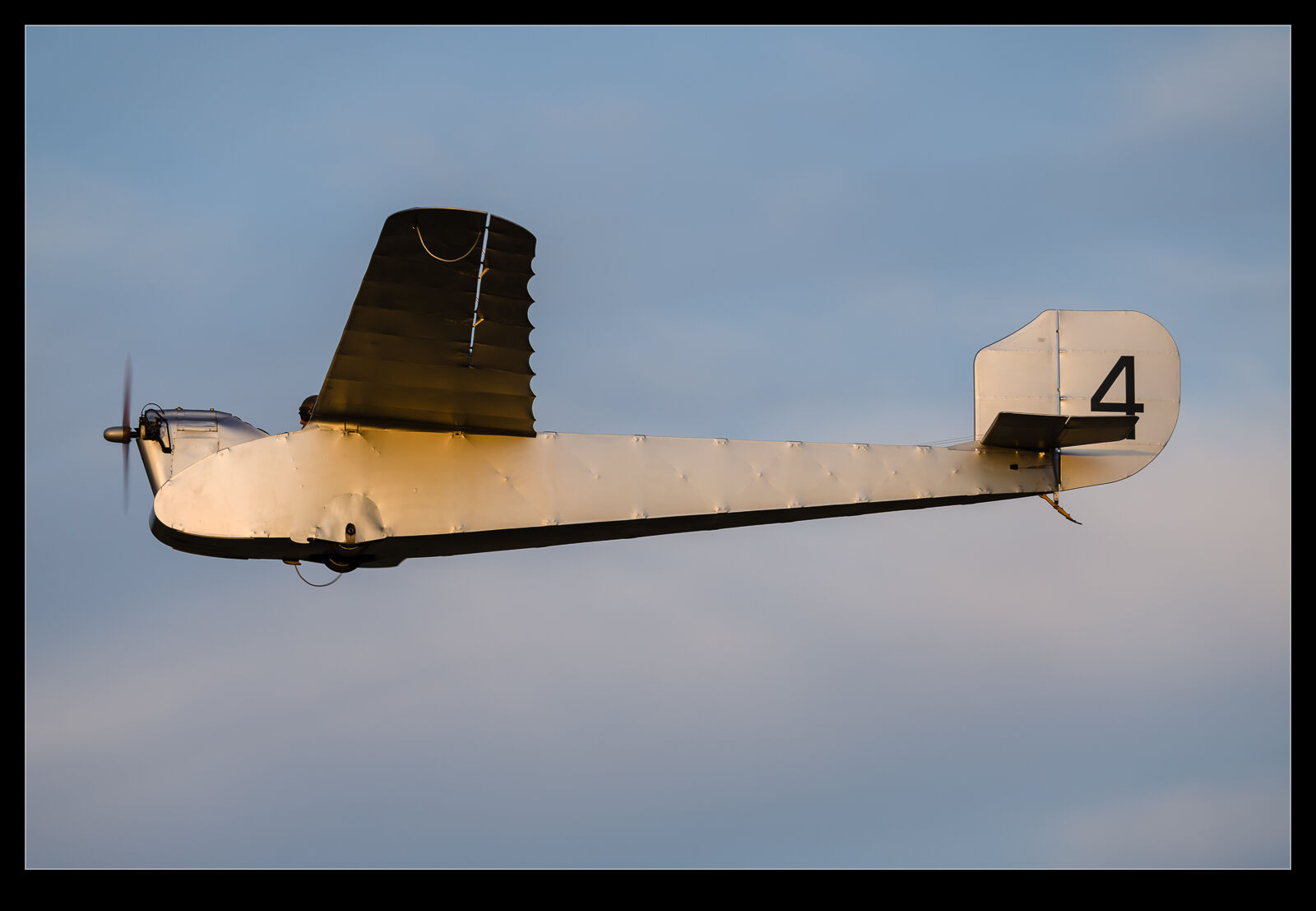 Multiple passes were made during the flight. The light was definitely playing ball along certain parts of the passes so I was able to grab quite a few shots. It’s not the most elegant looking plane and I imagine the view for the pilot is pretty minimal. Even so, as rarities go, it is right up there so to see it fly was a nice result.
Multiple passes were made during the flight. The light was definitely playing ball along certain parts of the passes so I was able to grab quite a few shots. It’s not the most elegant looking plane and I imagine the view for the pilot is pretty minimal. Even so, as rarities go, it is right up there so to see it fly was a nice result.
50 Years of Popham
 This aviation moment was a bit of a last-minute thing. We don’t live terribly far from Popham’s airfield, and I have driven past it more time than I can recall including when travelling to visit family in Andover before we ended up living in Hampshire. However, I had never actually been to the airfield before. I had seen that they were having a celebration of the fiftieth anniversary of the first use of the field, but I did have other stuff going on at home. When I had finished that, I knew I needed to get a bike ride in as part of my ongoing (if feeble) preparation for the charity ride I had coming up. I decided to ride up to Popham and back and swing by the fly in.
This aviation moment was a bit of a last-minute thing. We don’t live terribly far from Popham’s airfield, and I have driven past it more time than I can recall including when travelling to visit family in Andover before we ended up living in Hampshire. However, I had never actually been to the airfield before. I had seen that they were having a celebration of the fiftieth anniversary of the first use of the field, but I did have other stuff going on at home. When I had finished that, I knew I needed to get a bike ride in as part of my ongoing (if feeble) preparation for the charity ride I had coming up. I decided to ride up to Popham and back and swing by the fly in.
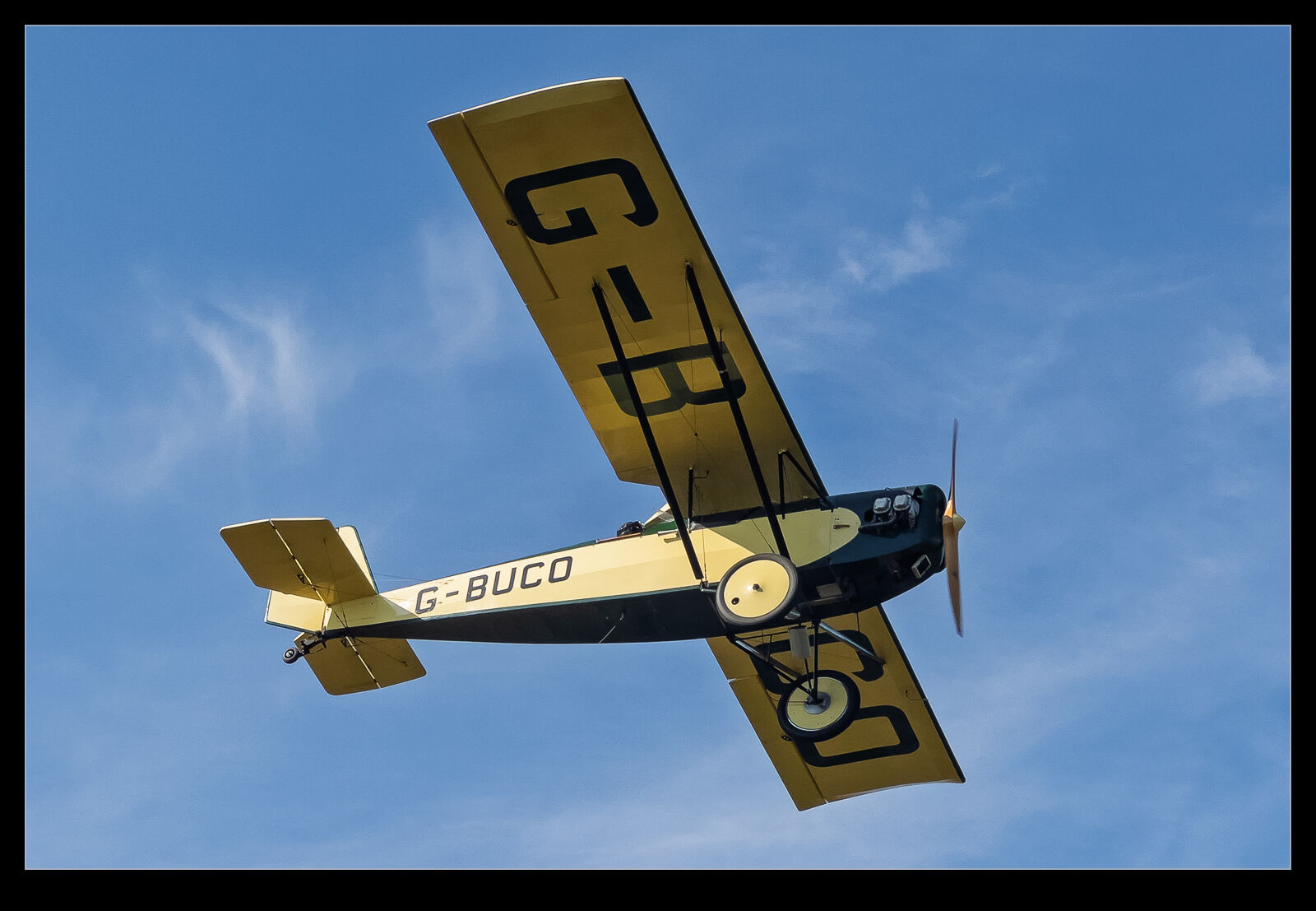 The weather was really nice and there seemed to be a ton of planes that had made the trip in to join the celebrations. The road into the airfield goes right under the western approach end and I did stop there on my bike for a while to watch the arriving and departing planes. Then I rode into the airfield itself and had a brief wander around. There were plenty of people out walking amongst the parked planes and, if I hadn’t been in cycling shoes and pushing the bike, I would have had a longer time exploring. Instead, it was a brief stopover before continuing my ride. I hope they had a successful day.
The weather was really nice and there seemed to be a ton of planes that had made the trip in to join the celebrations. The road into the airfield goes right under the western approach end and I did stop there on my bike for a while to watch the arriving and departing planes. Then I rode into the airfield itself and had a brief wander around. There were plenty of people out walking amongst the parked planes and, if I hadn’t been in cycling shoes and pushing the bike, I would have had a longer time exploring. Instead, it was a brief stopover before continuing my ride. I hope they had a successful day.
Reinforcement Around a Cargo Door
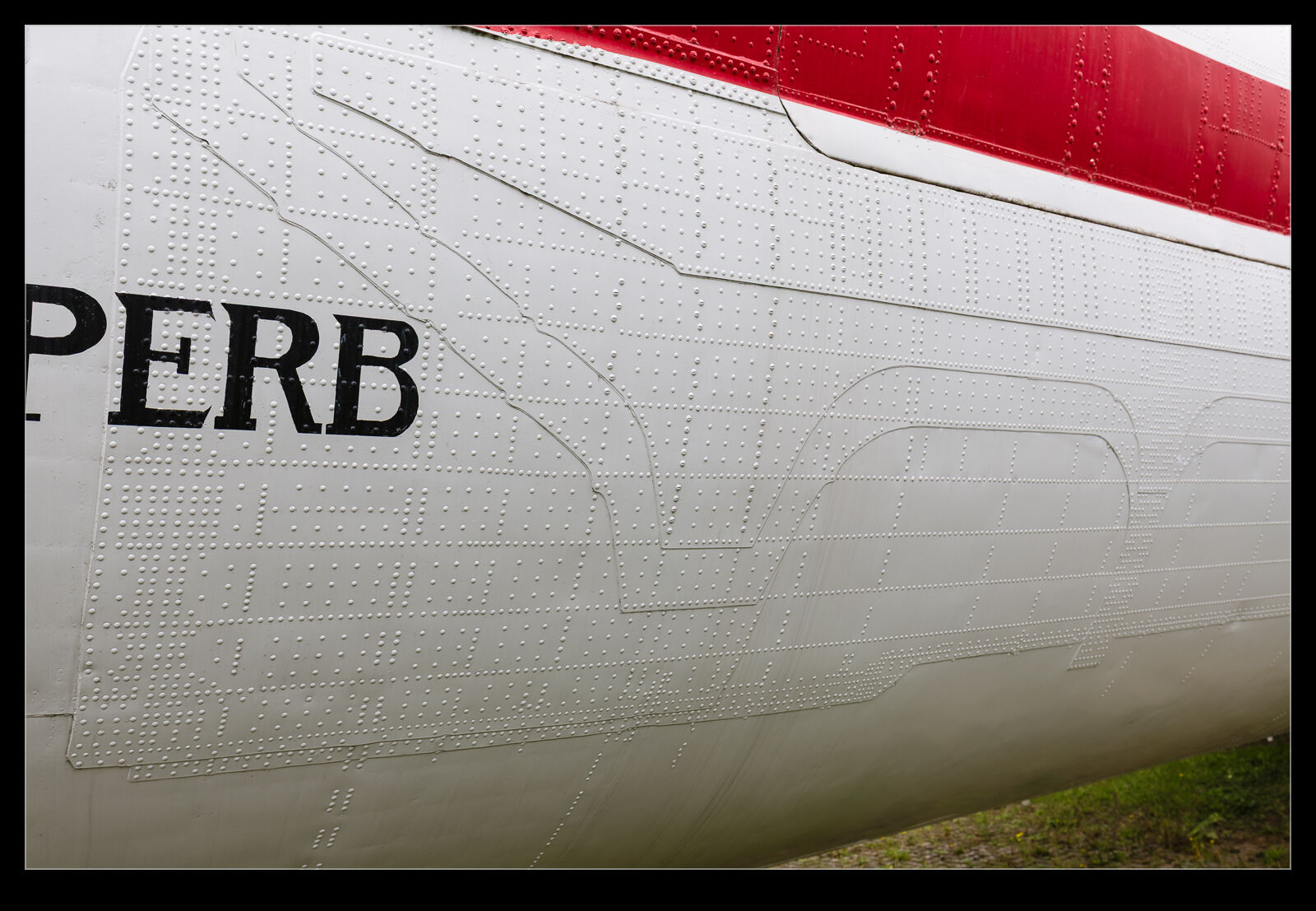 The Vickers Vanguard might not have had the sales success of its predecessor, the Viscount, but a number of the passenger planes had a long career as a result of conversion to the Merchantman freighter configuration. One of these is on display at the Brooklands Museum. Since the cargo door was not an original design feature, the fuselage needed to be reinforced to accommodate the stress redistribution around the door aperture.
The Vickers Vanguard might not have had the sales success of its predecessor, the Viscount, but a number of the passenger planes had a long career as a result of conversion to the Merchantman freighter configuration. One of these is on display at the Brooklands Museum. Since the cargo door was not an original design feature, the fuselage needed to be reinforced to accommodate the stress redistribution around the door aperture.
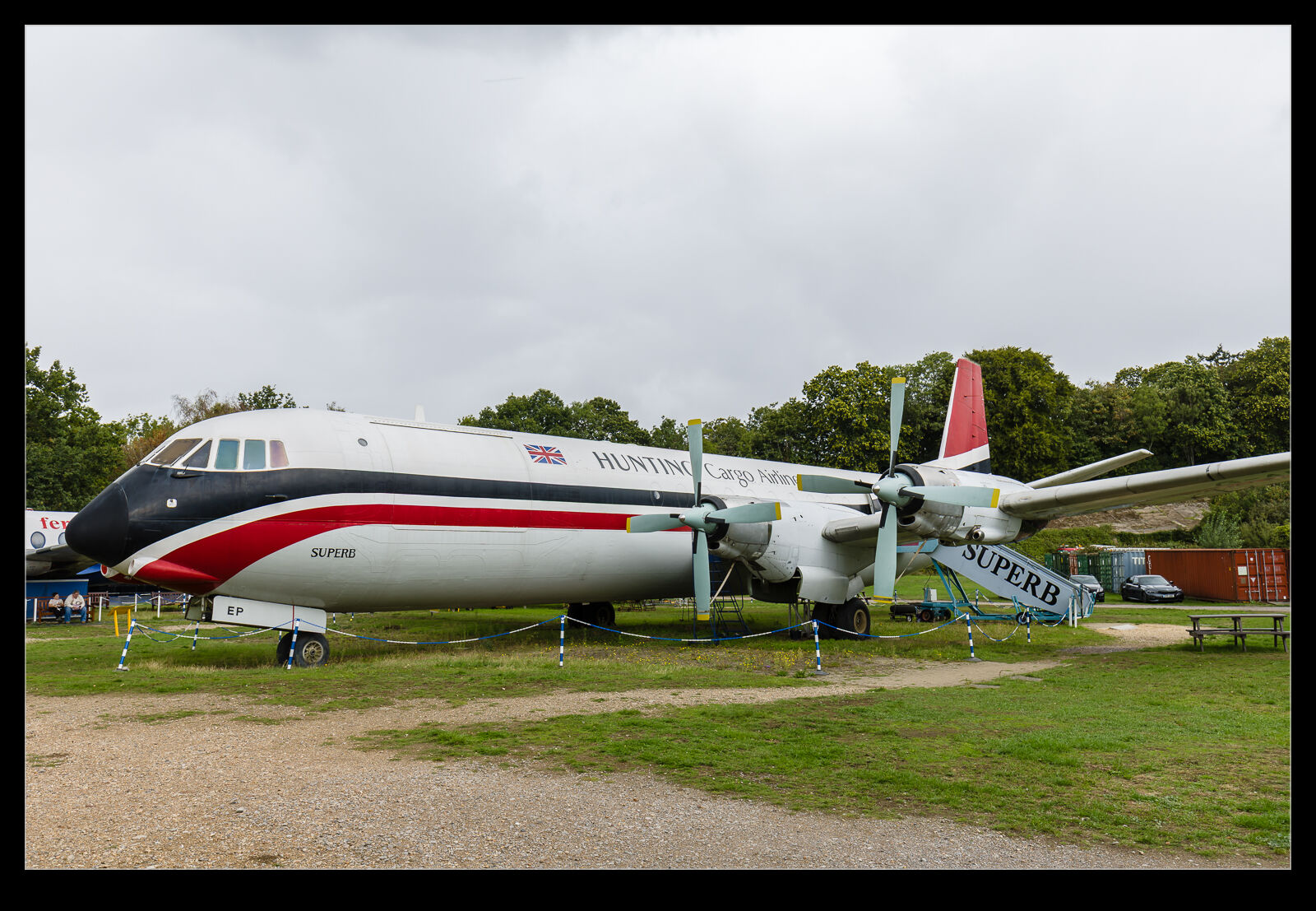 Since this was a retrofit, it was far simpler to have the reinforcement on the outside of the fuselage. Looking closely at the example at the museum, you can see the multiple layers of reinforcement to build up the thickness in the areas with the greatest stress increase. There were about ten layers in total with them tapering out as you got further from the opening. This was all prior to the days of finite element analysis so would have involved a lot of hand calculations!
Since this was a retrofit, it was far simpler to have the reinforcement on the outside of the fuselage. Looking closely at the example at the museum, you can see the multiple layers of reinforcement to build up the thickness in the areas with the greatest stress increase. There were about ten layers in total with them tapering out as you got further from the opening. This was all prior to the days of finite element analysis so would have involved a lot of hand calculations!
Tanking Typhoons
 I had the good fortune to be able to spend a day with 101 Sqn of the Royal Air Force when they were undertaking training missions in one of their primary roles of aerial refuelling. Based at RAF Brize Norton, the squadron operates the Airbus Voyager, the A330MRTT aircraft. The aircraft we were in was configured for two-point refuelling while some of the aircraft have a three-point config that allows tanking of heavy aircraft from the higher capacity centreline hose drum unit.
I had the good fortune to be able to spend a day with 101 Sqn of the Royal Air Force when they were undertaking training missions in one of their primary roles of aerial refuelling. Based at RAF Brize Norton, the squadron operates the Airbus Voyager, the A330MRTT aircraft. The aircraft we were in was configured for two-point refuelling while some of the aircraft have a three-point config that allows tanking of heavy aircraft from the higher capacity centreline hose drum unit.
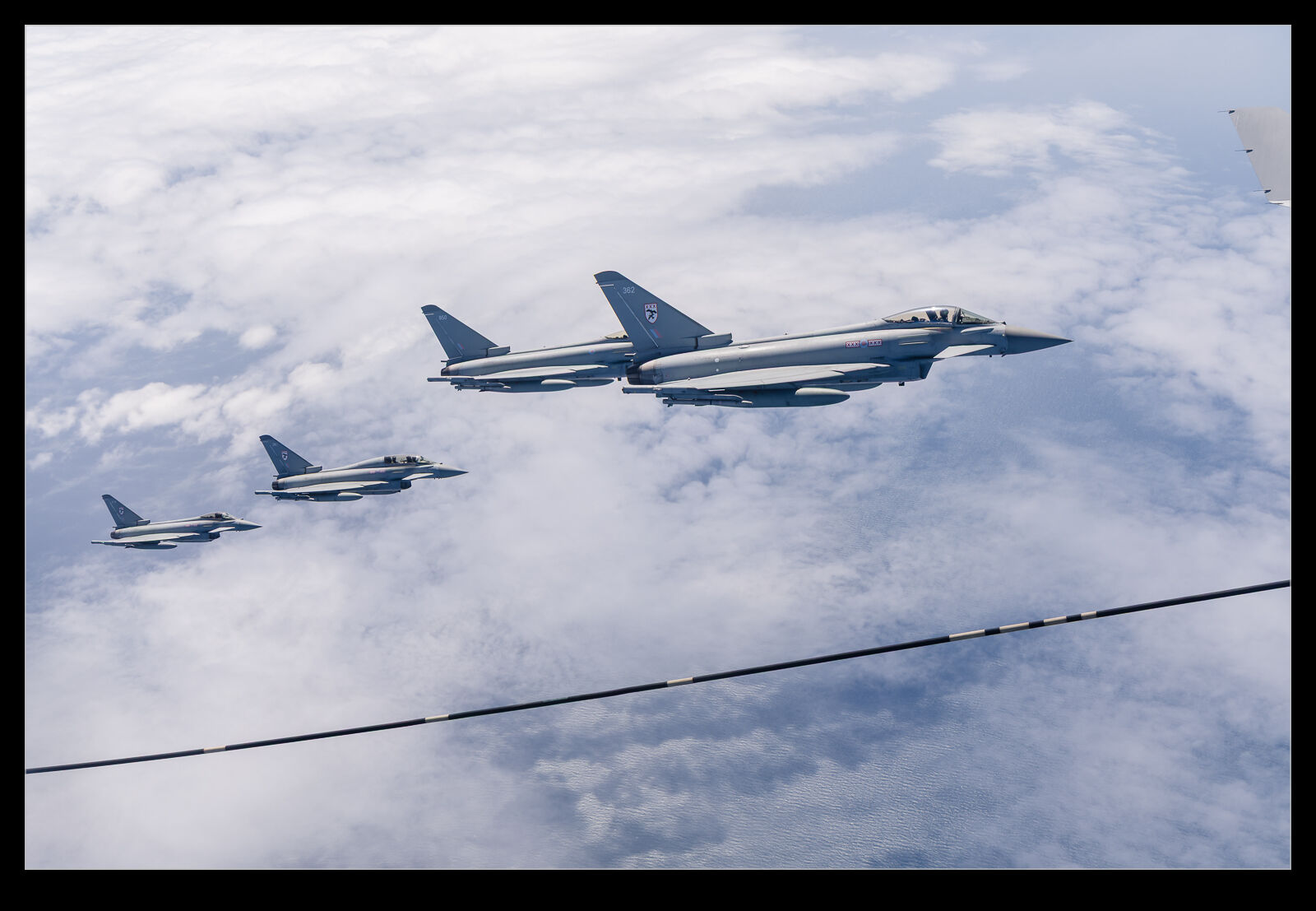 We took off from Brize and headed out over the North Sea. Our initial tracks were off the coast of East Anglia which made for a convenient place to pick up trade from the RAF bases there. The F-35s were deployed from Marham so there was less likelihood of one of those jets showing up, but we did expect Typhoons. It was too long after we were on station before the first customers showed up.
We took off from Brize and headed out over the North Sea. Our initial tracks were off the coast of East Anglia which made for a convenient place to pick up trade from the RAF bases there. The F-35s were deployed from Marham so there was less likelihood of one of those jets showing up, but we did expect Typhoons. It was too long after we were on station before the first customers showed up.
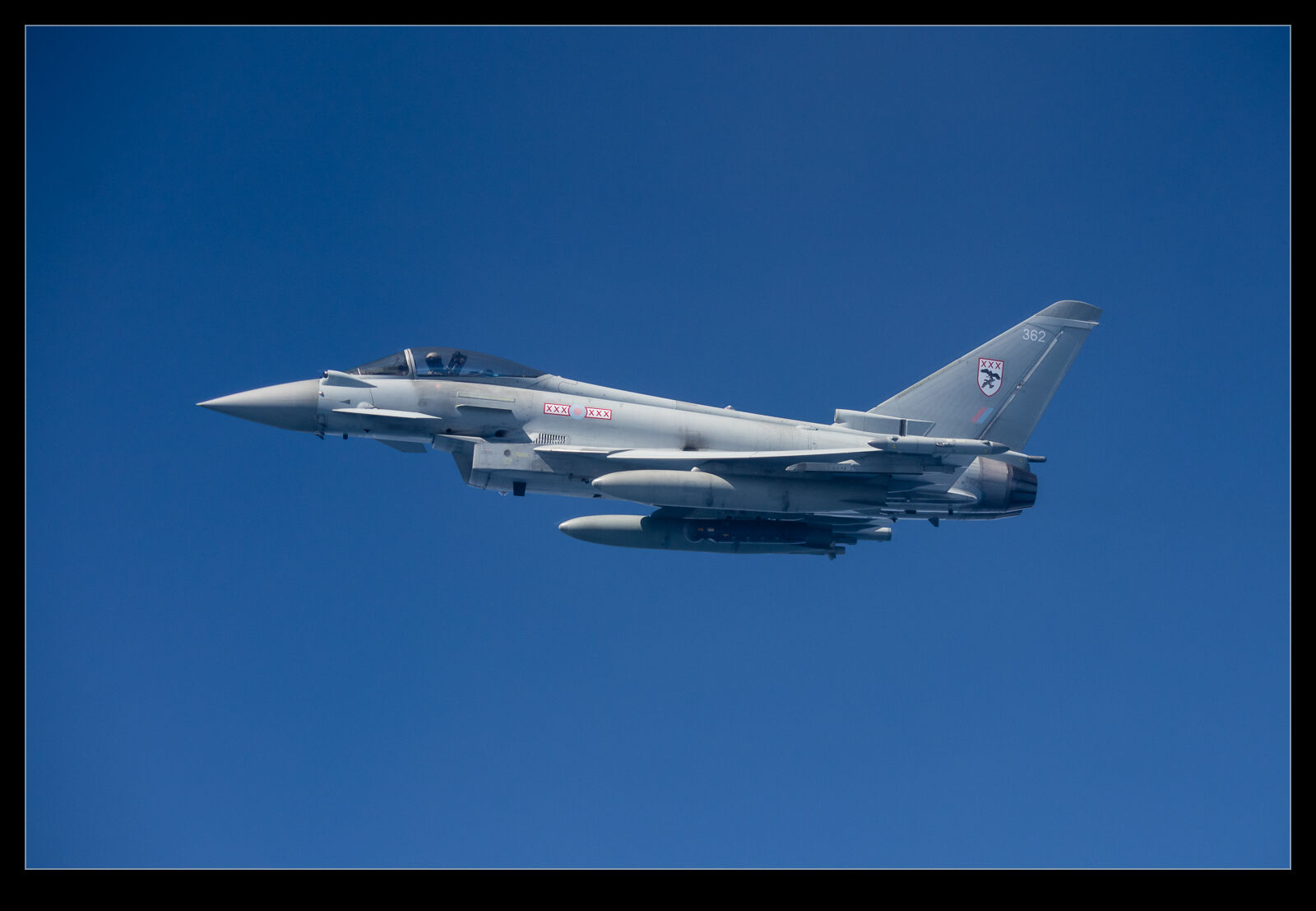 The jets appeared from the port side of the jet and picking them up early allowed you to see them sweeping in astern of the plane before they approached from astern. They would gather off the port wing extending the refuelling probe before being cleared into pre-contact positions on either wing. Then they would pull forward to make contact and take on fuel. Once they were done, they would gather off the starboard wing until the flight had all taken on fuel at which point they would accelerate away to continue with their flight. This departure might just be peeling away but it sometimes included a burst of power and a climb up away from our flight level with the noise even being noticeable inside our insulated cabin.
The jets appeared from the port side of the jet and picking them up early allowed you to see them sweeping in astern of the plane before they approached from astern. They would gather off the port wing extending the refuelling probe before being cleared into pre-contact positions on either wing. Then they would pull forward to make contact and take on fuel. Once they were done, they would gather off the starboard wing until the flight had all taken on fuel at which point they would accelerate away to continue with their flight. This departure might just be peeling away but it sometimes included a burst of power and a climb up away from our flight level with the noise even being noticeable inside our insulated cabin.
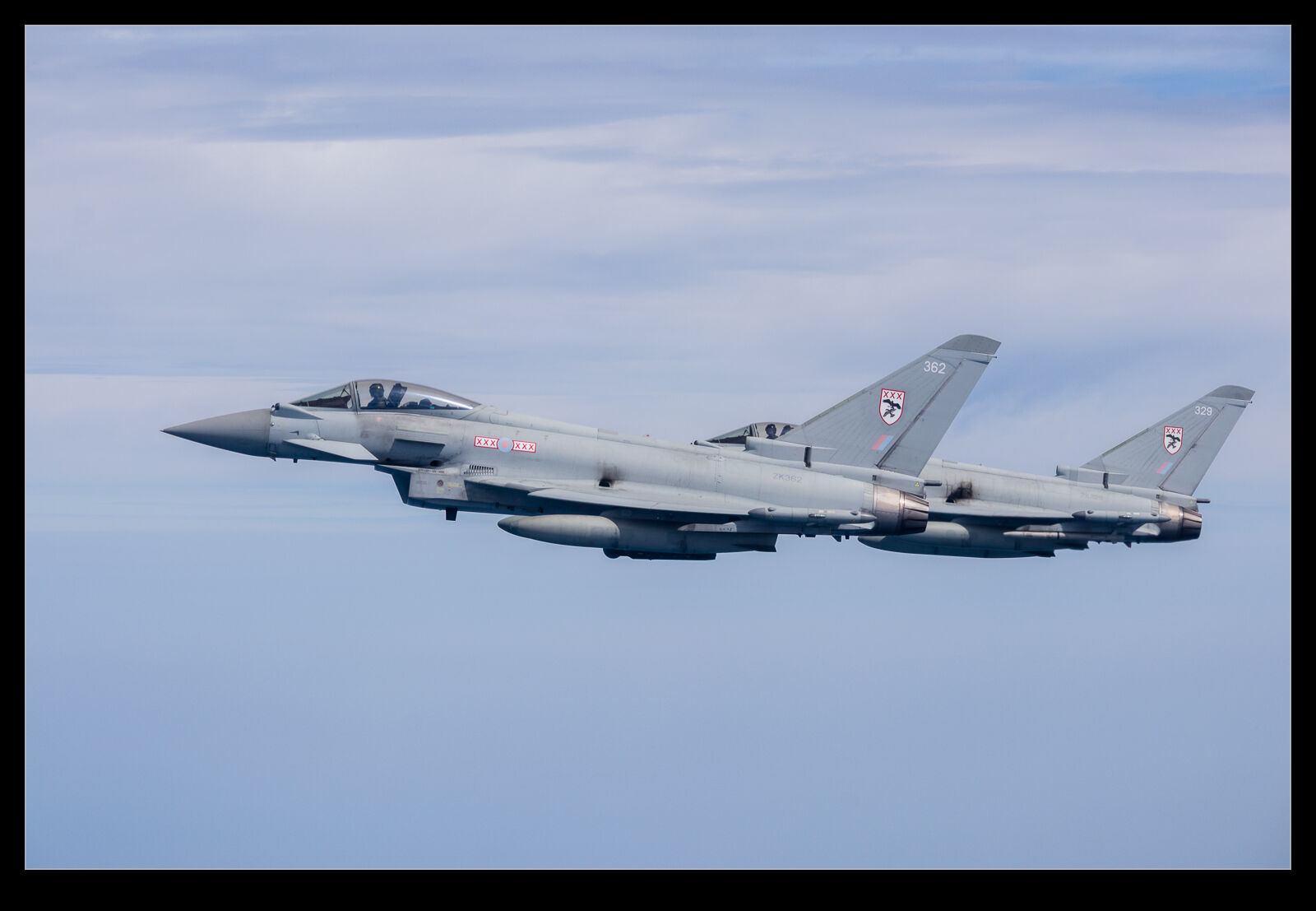 There are very limited options when it comes to photographing the jets while they are plugged in. The pods are mounted outboard on the wings – I think in the location where the outboard engines would be on an A340 – but the length of the hose means that the drogue is quite a long way aft. This means that only the last few rows of the aircraft – it has a pretty standard seating config throughout most of the fuselage – actually have the ability to see the jets. I had been advised by a friend that the viewing was limited.
There are very limited options when it comes to photographing the jets while they are plugged in. The pods are mounted outboard on the wings – I think in the location where the outboard engines would be on an A340 – but the length of the hose means that the drogue is quite a long way aft. This means that only the last few rows of the aircraft – it has a pretty standard seating config throughout most of the fuselage – actually have the ability to see the jets. I had been advised by a friend that the viewing was limited.
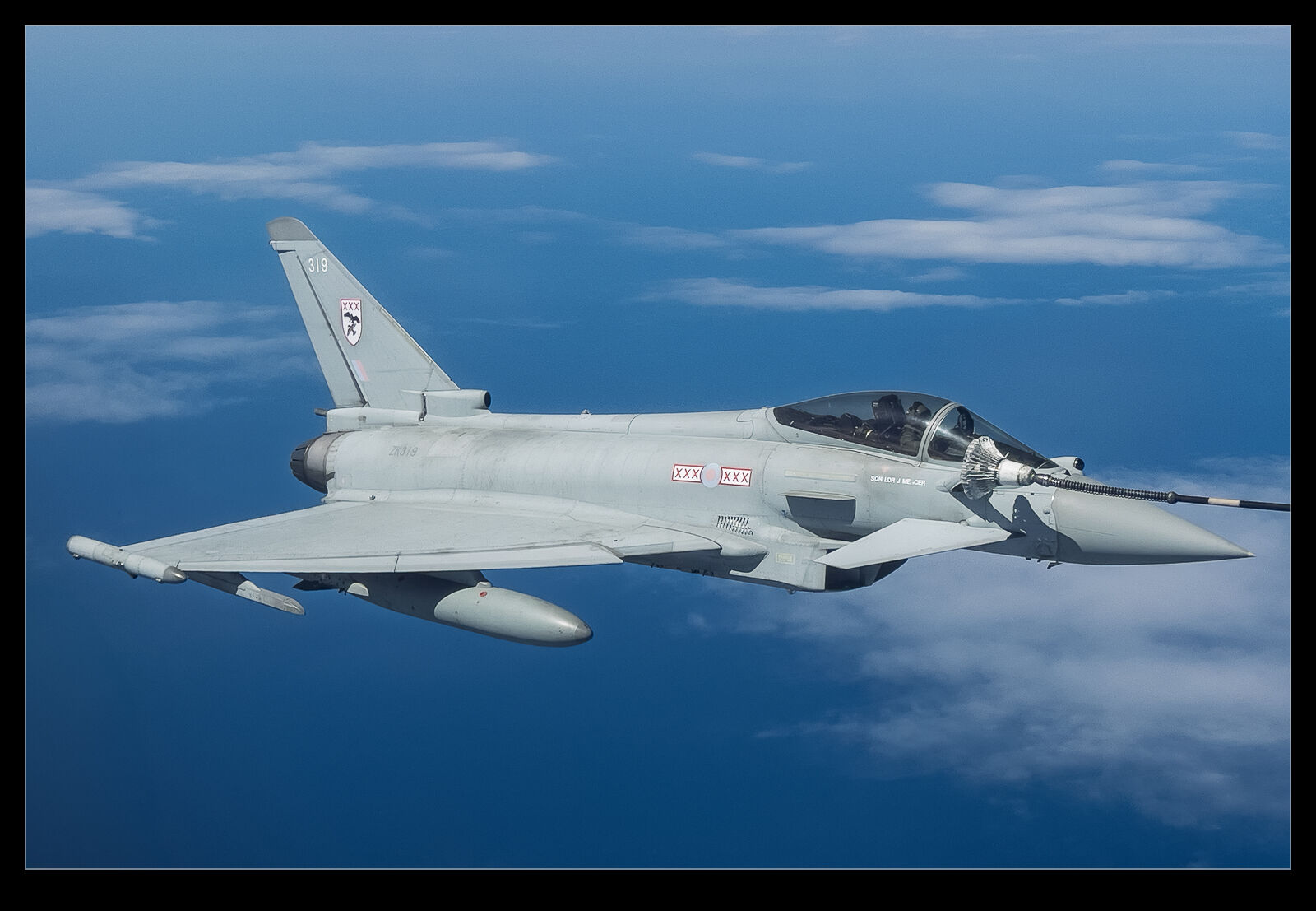 I had brought two cameras on the flight. My main camera was fitted with the 100-400 lens and my use for that was on aircraft off to either side. The other body I brought along was an older one I use less frequently these days and that is the M6 with a 55-200 lens. This ended up getting a lot of use. However, neither of them was suitable for use when the jets were refuelling. The angles looking back are tight and the interior panelling around the window apertures limits how you can point backwards. In this case, the phone was by far the best option. The small lens diameter combined with the ability to get it close to the window meant it was the best bet. Even then, it was limited in what it could see.
I had brought two cameras on the flight. My main camera was fitted with the 100-400 lens and my use for that was on aircraft off to either side. The other body I brought along was an older one I use less frequently these days and that is the M6 with a 55-200 lens. This ended up getting a lot of use. However, neither of them was suitable for use when the jets were refuelling. The angles looking back are tight and the interior panelling around the window apertures limits how you can point backwards. In this case, the phone was by far the best option. The small lens diameter combined with the ability to get it close to the window meant it was the best bet. Even then, it was limited in what it could see.
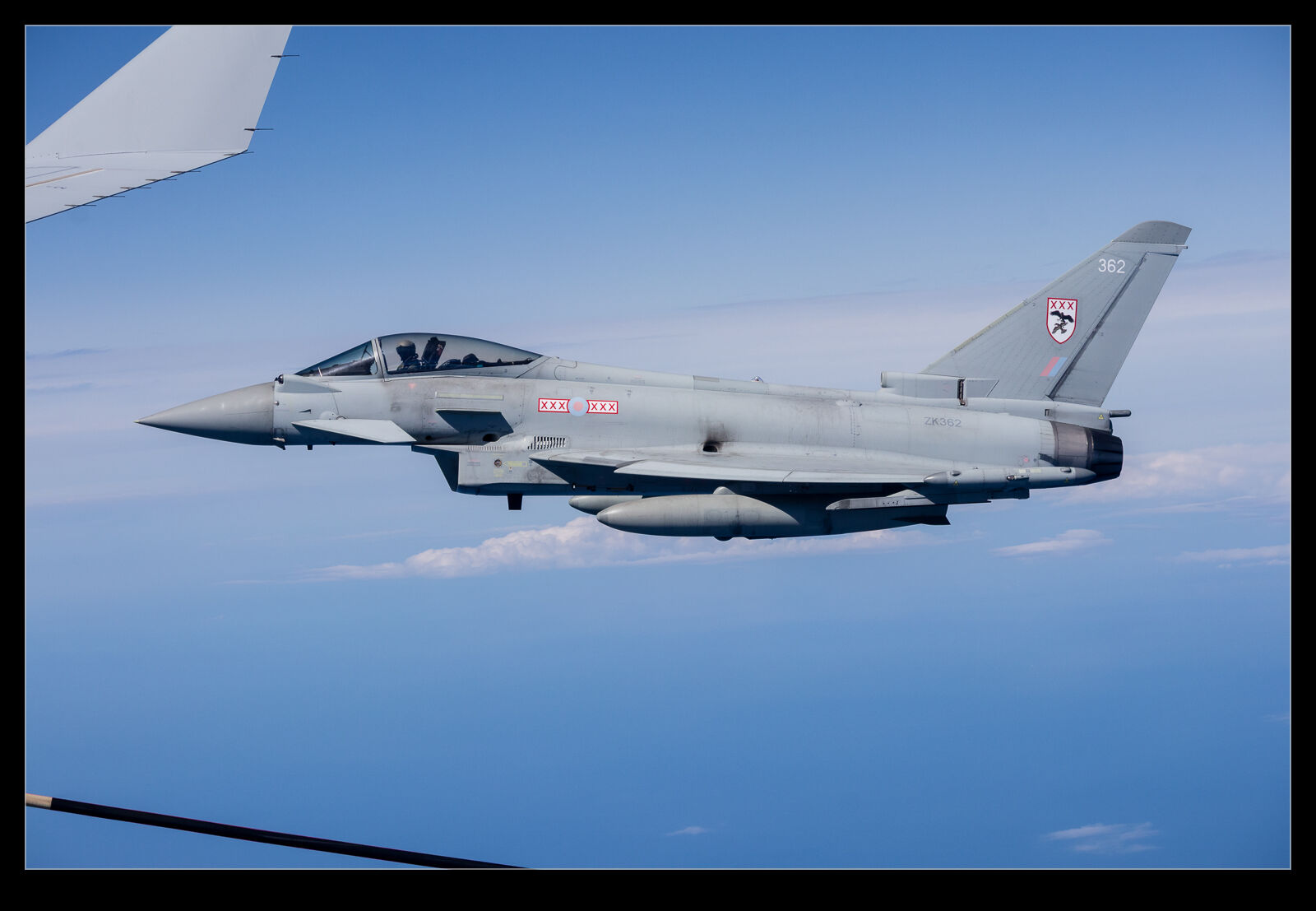 Later in the mission we headed up towards Scotland to pick up some local trade although, ironically, we ended up with jets from Coningsby which would probably have been fine in our original tracks. Overall, the mission last over 6 hours and we had a variety of periods when we had customers and then periods of waiting. It was definitely an interesting day out and certainly worth seeing. My thanks to the team at Brize for hosting us so well.
Later in the mission we headed up towards Scotland to pick up some local trade although, ironically, we ended up with jets from Coningsby which would probably have been fine in our original tracks. Overall, the mission last over 6 hours and we had a variety of periods when we had customers and then periods of waiting. It was definitely an interesting day out and certainly worth seeing. My thanks to the team at Brize for hosting us so well.
The Atlantique is a Great Throwback
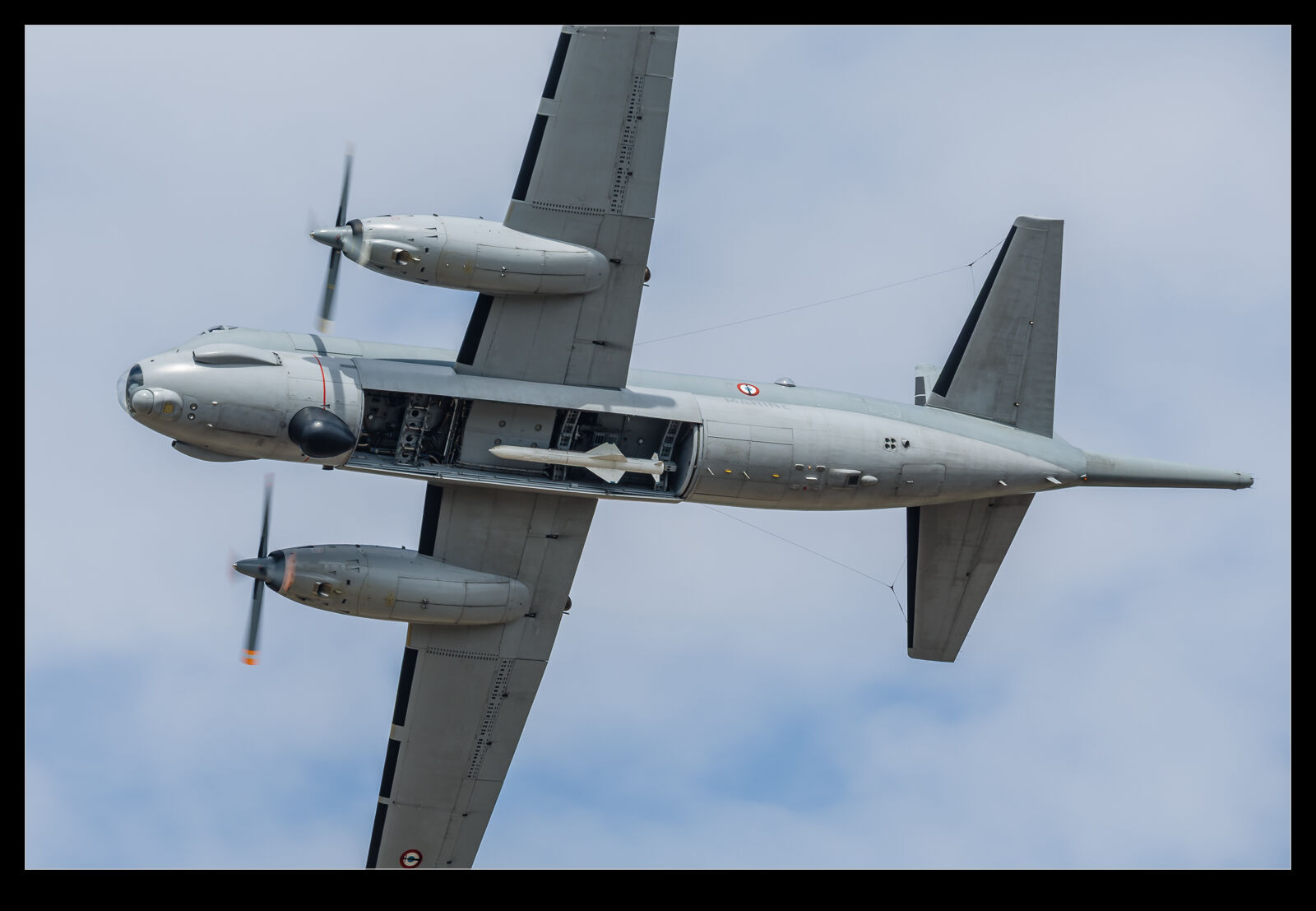 RIAT provided many high points for me this year. One of the types I haven’t seen for a long time was the Atlantique operated by the French Navy. I think I last saw one at Mildenhall at an Air Fete at the beginning of the 90s. Not only was the plane on the ground but it was also taking part in the flying display. Powered by a pair of Tyne turboprops, the engine whine on the ground is quite painful. You do need to give your ears some protection to avoid it getting too much. Once those engines are ramped up to take off power, the humid conditions meant some nice prop vortices showed up.
RIAT provided many high points for me this year. One of the types I haven’t seen for a long time was the Atlantique operated by the French Navy. I think I last saw one at Mildenhall at an Air Fete at the beginning of the 90s. Not only was the plane on the ground but it was also taking part in the flying display. Powered by a pair of Tyne turboprops, the engine whine on the ground is quite painful. You do need to give your ears some protection to avoid it getting too much. Once those engines are ramped up to take off power, the humid conditions meant some nice prop vortices showed up.
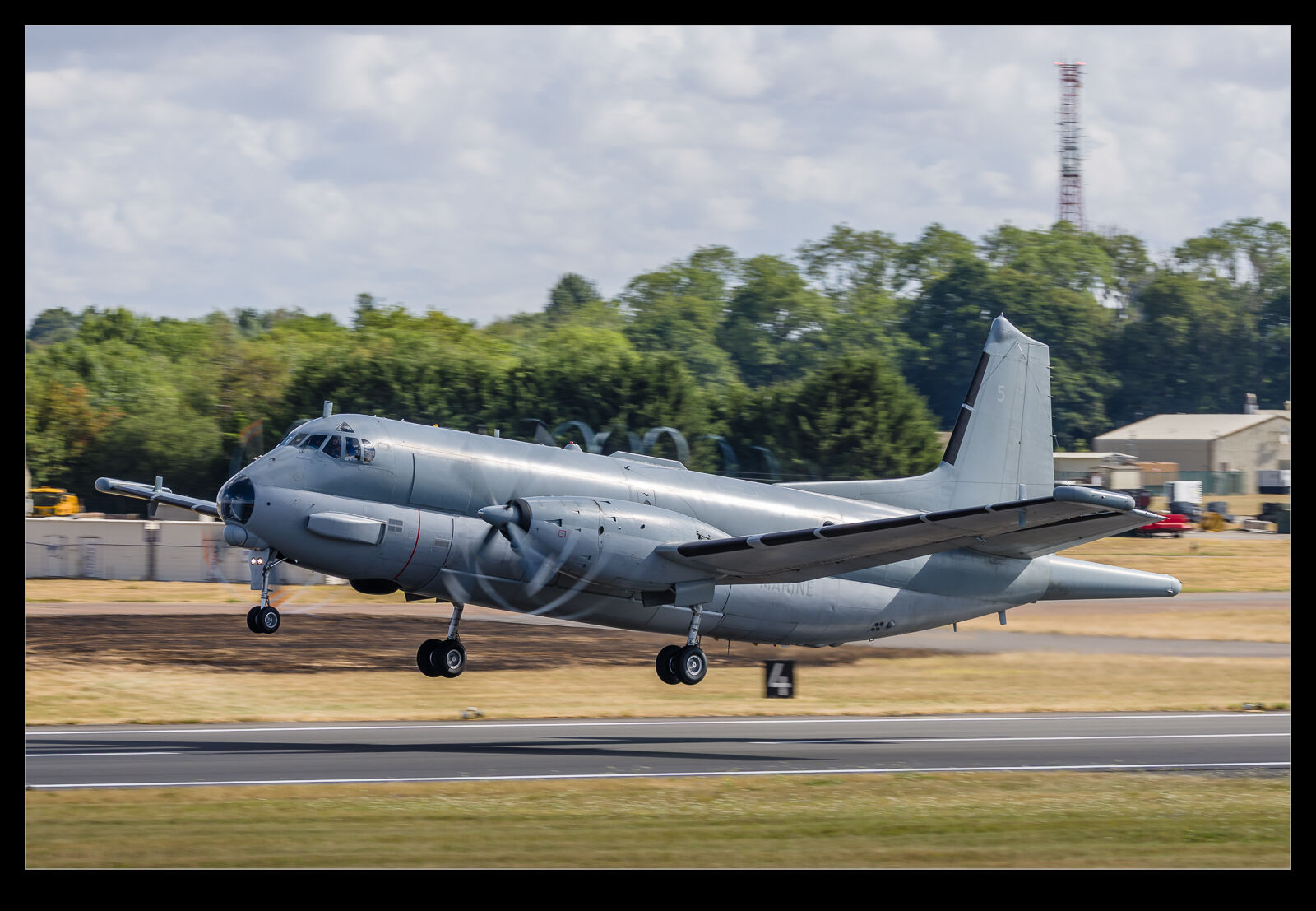 The display consisted of a number of passes. There is a radar installation that retracts into the fuselage for take off and landing as well as when it isn’t needed and drag reduction is more valuable. For some of the passes this radar was extended. Also, there is a large underfuselage weapons bay and the doors to this were opened to reveal a captive Exocet missile. The Exocet is a large weapon, and you really appreciate that when it is shown against a plane as large as the Atlantique. The French Navy is planning on introducing a new type based on a Falcon business jet so the chances to see an Atlantique will be diminishing soon.
The display consisted of a number of passes. There is a radar installation that retracts into the fuselage for take off and landing as well as when it isn’t needed and drag reduction is more valuable. For some of the passes this radar was extended. Also, there is a large underfuselage weapons bay and the doors to this were opened to reveal a captive Exocet missile. The Exocet is a large weapon, and you really appreciate that when it is shown against a plane as large as the Atlantique. The French Navy is planning on introducing a new type based on a Falcon business jet so the chances to see an Atlantique will be diminishing soon.
